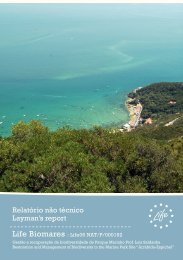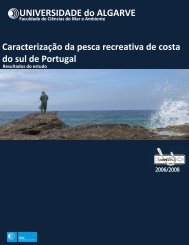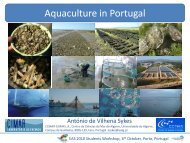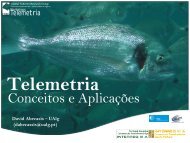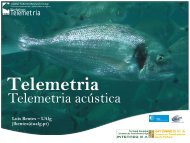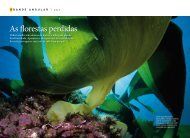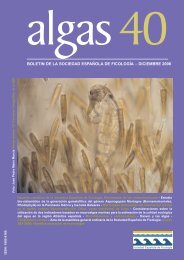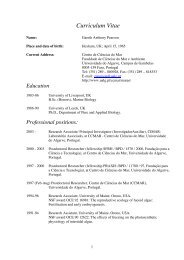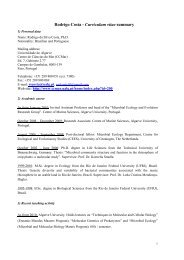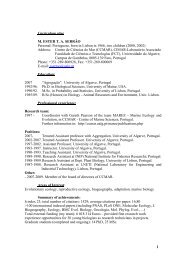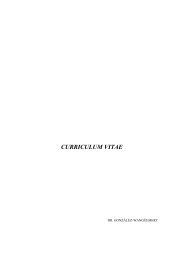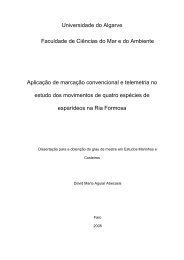Seagrasses in Portugal: A most endangered marine habitat
Seagrasses in Portugal: A most endangered marine habitat
Seagrasses in Portugal: A most endangered marine habitat
You also want an ePaper? Increase the reach of your titles
YUMPU automatically turns print PDFs into web optimized ePapers that Google loves.
G Model<br />
AQBOT-2409; No. of Pages 11<br />
ARTICLE IN PRESS<br />
Aquatic Botany xxx (2011) xxx– xxx<br />
Contents lists available at SciVerse ScienceDirect<br />
Aquatic Botany<br />
j ourna l ho me page: www.elsevier.com/locate/aquabot<br />
<strong>Seagrasses</strong> <strong>in</strong> <strong>Portugal</strong>: A <strong>most</strong> <strong>endangered</strong> mar<strong>in</strong>e <strong>habitat</strong><br />
Alexandra H. Cunha ∗ , Jorge F. Assis, Ester A. Serrão<br />
CCMAR – Centro de Ciências do Mar, Edifício 7, Universidade do Algarve, Campus de Gambelas, 8005-139 Faro, <strong>Portugal</strong><br />
a r t i c l e i n f o<br />
Article history:<br />
Received 23 July 2010<br />
Received <strong>in</strong> revised form 22 August 2011<br />
Accepted 26 August 2011<br />
Available onl<strong>in</strong>e xxx<br />
Keywords:<br />
Geographic distribution<br />
Habitat ext<strong>in</strong>ction<br />
Long-term change<br />
Mar<strong>in</strong>e conservation<br />
Population decl<strong>in</strong>e<br />
<strong>Portugal</strong><br />
Seagrass cover<br />
Seagrass decl<strong>in</strong>e<br />
1. Introduction<br />
a b s t r a c t<br />
Seagrass meadows are decl<strong>in</strong><strong>in</strong>g around the world at an unprecedented<br />
rate, suggest<strong>in</strong>g a global crisis, yet <strong>most</strong> of the references<br />
are from a few highly developed countries (Orth et al., 2006; Duarte<br />
et al., 2009). Indeed, along extensive coastl<strong>in</strong>es, there is no published<br />
<strong>in</strong>formation on seagrass distribution patterns and historical<br />
trends are unknown (Duarte et al., 2008). Reported losses (29%<br />
of the maximum area measured; Waycott et al., 2009), probably<br />
represent a small fraction of those that have occurred, many losses<br />
rema<strong>in</strong> unreported, and real losses may never be known because<br />
<strong>most</strong> will disappear without ever hav<strong>in</strong>g been reported to have<br />
occurred (Duarte et al., 2008). Strik<strong>in</strong>g seagrass losses have been<br />
documented <strong>in</strong> North America, Europe and Australia (Orth et al.,<br />
2006; Waycott et al., 2009). Major gaps <strong>in</strong> knowledge of seagrass<br />
cover and distribution exist for West Africa (Duarte et al., 2008;<br />
Cunha and Araújo, 2009), northeast South America, the northwest<br />
Pacific and the tropical Indo-Pacific (from East Africa to Hawaii)<br />
where seagrasses are widespread and abundant (Waycott et al.,<br />
2009).<br />
∗ Correspond<strong>in</strong>g author. Tel.: +351 289 800 051; fax: +351 289 800 051.<br />
E-mail address: acunha@ualg.pt (A.H. Cunha).<br />
0304-3770/$ – see front matter ©<br />
2011 Elsevier B.V. All rights reserved.<br />
doi:10.1016/j.aquabot.2011.08.007<br />
Numerous reports of seagrass decl<strong>in</strong>e around the world <strong>in</strong>dicate that seagrass <strong>habitat</strong>s are undergo<strong>in</strong>g a<br />
global crisis with important consequences for coastal biodiversity, environmental status and economy,<br />
reflect<strong>in</strong>g their vulnerable and overlooked status with<strong>in</strong> many conservation agendas.<br />
This paper describes the results of the first extensive survey of this <strong>habitat</strong> <strong>in</strong> <strong>Portugal</strong>. It shows the<br />
present cover distribution and decl<strong>in</strong><strong>in</strong>g trends of seagrasses on the Portuguese coast (1980–2010),<br />
identifies environmental and conservation issues, and discusses challenges for long-term survival.<br />
Seagrass populations of the Portuguese coast are also fac<strong>in</strong>g an unprecedented decl<strong>in</strong>e <strong>in</strong> distribution,<br />
match<strong>in</strong>g the general trends described for <strong>most</strong> world seagrasses. The results of this <strong>in</strong>vestigation show a<br />
dramatic decrease of seagrass cover <strong>in</strong> <strong>Portugal</strong> <strong>in</strong> the last 20 years. This decrease followed different trends<br />
for the three species present on this coast. Zostera noltii, hav<strong>in</strong>g disappeared from some systems by al<strong>most</strong><br />
75%, is still the <strong>most</strong> abundant species, present <strong>in</strong> 10 of the 18 sites assessed. Zostera mar<strong>in</strong>a is presently<br />
the <strong>most</strong> <strong>endangered</strong> seagrass species <strong>in</strong> <strong>Portugal</strong>, as it disappeared from six of eight historical locations<br />
and faces ext<strong>in</strong>ction from the Portuguese territory if measures are not taken to assure the protection<br />
of the last regions left with populations. Cymodocea nodosa has a geographic distribution range limited<br />
to the southern/southwestern coasts, and its current conservation status is uncerta<strong>in</strong>, although there is<br />
evidence for the recent occurrence of several population bottlenecks.<br />
Management questions are discussed and actions to improve <strong>habitat</strong> conservation are suggested.<br />
© 2011 Elsevier B.V. All rights reserved.<br />
In southern Europe and the Mediterranean, with some localized<br />
exceptions for Posidonia oceanica, <strong>in</strong>formation on seagrass<br />
distribution and abundance trends are scarce. <strong>Portugal</strong>, although<br />
entirely on the Atlantic coast, forms a biogeographic admixture<br />
zone where Atlantic species at their southern<strong>most</strong> distributional<br />
limits encounter Mediterranean and African species that extend<br />
northwards. Furthermore, signatures of past climatic events, possibly<br />
<strong>in</strong>teract<strong>in</strong>g with local adaptation traits for these seagrass<br />
species with contrast<strong>in</strong>g environmental aff<strong>in</strong>ities, have resulted <strong>in</strong> a<br />
unique population genetic constellation of the seagrasses along the<br />
Portuguese coast (Olsen et al., 2004; Coyer et al., 2004; Diekmann<br />
et al., 2005; Alberto et al., 2008).<br />
The Portuguese coast is the northern limit <strong>in</strong> the Atlantic for<br />
Cymodocea nodosa (Ucria) Ascherson, and it is presently the southern<br />
distributional limit for Zostera mar<strong>in</strong>a L<strong>in</strong>naeus 1753 (Cabaç o<br />
and Santos, 2010; Bull et al., 2010). It is also the center of the<br />
distributional range for Zostera noltii Hornemann 1832, a <strong>most</strong>ly<br />
<strong>in</strong>tertidal species rang<strong>in</strong>g from Mauritania (Cunha and Araújo,<br />
2009), to the southern fjords of Norway (den Hartog, 1970). Among<br />
all four native seagrass species of Europe (sensu stricto) only the<br />
Mediterranean endemic P. oceanica (L<strong>in</strong>naeus) Delile is not present<br />
<strong>in</strong> <strong>Portugal</strong>, mak<strong>in</strong>g this coastl<strong>in</strong>e particularly unique <strong>in</strong> terms of<br />
European seagrass biodiversity. Two other more typically brackish<br />
aquatic plant species are present on the Portuguese coastal ecosystems,<br />
Ruppia maritima and Ruppia cirrhosa. They are present <strong>in</strong><br />
Please cite this article <strong>in</strong> press as: Cunha, A.H., et al., <strong>Seagrasses</strong> <strong>in</strong> <strong>Portugal</strong>: A <strong>most</strong> <strong>endangered</strong> mar<strong>in</strong>e <strong>habitat</strong>. Aquat. Bot. (2011),<br />
doi:10.1016/j.aquabot.2011.08.007
ARTICLE IN PRESS<br />
G Model<br />
AQBOT-2409; No. of Pages 11<br />
2 A.H. Cunha et al. / Aquatic Botany xxx (2011) xxx– xxx<br />
Fig. 1. Seagrass distribution <strong>in</strong> the Portuguese coast, depict<strong>in</strong>g the 21 sites visited and <strong>in</strong>formation on seagrass presence/absence, and species present.<br />
coastal lagoons with higher <strong>in</strong>fluence of freshwater and, although<br />
they were not target species <strong>in</strong> this study, their distribution is briefly<br />
reported for some sites, particularly where they mix <strong>in</strong> with the<br />
3 seagrass species.<br />
This paper depicts the first full assessment of the distribution,<br />
cover and conservation status of the Portuguese seagrasses. We<br />
report decreases <strong>in</strong> seagrass cover or even total disappearance<br />
along the Portuguese coast and highlight the need to evaluate past<br />
versus current distribution and ascerta<strong>in</strong> the conservation status of<br />
Portuguese seagrasses.<br />
2. Materials and methods<br />
2.1. Study site<br />
The Portuguese west coast extends for ca. 800 km along a<br />
straight North-South orientation, whereas the south coast, extends<br />
for ca. 200 km West–East (Fig. 1). Estuaries along this coastl<strong>in</strong>e vary<br />
significantly <strong>in</strong> geomorphologic and hydrologic features. While the<br />
Tagus and the Sado rivers estuaries have the broadest areas (ranges<br />
320–180 km 2 ), the Mondego, Mira, Arade and Guadiana rivers are<br />
channel-like (ranges 20–5 km 2 ). Ria de Aveiro, Ria de Alvor and<br />
Ria Formosa are shallow coastal barrier islands lagoon systems<br />
(ranges 6–91 km 2 ). Annual river flow is markedly different, with the<br />
Tagus estuary present<strong>in</strong>g mean values above 250 m 3 s −1 , and the<br />
Mira and the Ria Formosa discharg<strong>in</strong>g on average below 5 m 3 s −1<br />
(V<strong>in</strong>agre et al., 2010). Sal<strong>in</strong>ity varies seasonally from a mean of<br />
21.2 (9.3–31.8) <strong>in</strong> Mondego river, to 36.9 (35.0–39.0) <strong>in</strong> Sado river<br />
(V<strong>in</strong>agre et al., 2010). The two coasts are subject to different climate<br />
and storm regimes, with the northern coast subjected to more<br />
<strong>in</strong>tense westerly and northern w<strong>in</strong>ds. Both are very exposed to southern<br />
storms, which can be frequent and very <strong>in</strong>tense <strong>in</strong> certa<strong>in</strong><br />
times of the year. Because of different current exposure and latitude<br />
water temperature ranges are very wide between the study<br />
sites with lowest means of 14 ◦ C <strong>in</strong> the Arrábida coast <strong>in</strong> w<strong>in</strong>ter,<br />
to highest means of 27 ◦ C <strong>in</strong> Ria Formosa and Guadiana river <strong>in</strong><br />
summer (V<strong>in</strong>agre et al., 2010).<br />
2.2. Distribution and cover assessment techniques<br />
The current distributional patterns of seagrasses <strong>in</strong> <strong>Portugal</strong><br />
were assessed from 2007 to 2010 dur<strong>in</strong>g the LIFE Biomares project<br />
(LIFE 06 NAT/P/192) that aimed at restoration of a seagrass meadow<br />
<strong>in</strong> the Mar<strong>in</strong>e Park Luiz Saldanha, on the Arrábida coast (Cunha<br />
et al., 2009, <strong>in</strong> press). Sites surveyed were selected because they had<br />
either previous written or oral records of present or past seagrass<br />
presence, or because seagrass-like cover areas were identified <strong>in</strong><br />
aerial photos or Google Earth ® images.<br />
The methods used for seagrass cover assessment are described<br />
<strong>in</strong> detail <strong>in</strong> Cunha et al. (2009). Different approaches were used<br />
because the sites varied <strong>in</strong> their availability of prior <strong>in</strong>formation<br />
and <strong>in</strong> access to the field sites. For <strong>in</strong>tertidal and shallow subtidal<br />
field sites with clear water conditions and <strong>in</strong>accessible by boat,<br />
Please cite this article <strong>in</strong> press as: Cunha, A.H., et al., <strong>Seagrasses</strong> <strong>in</strong> <strong>Portugal</strong>: A <strong>most</strong> <strong>endangered</strong> mar<strong>in</strong>e <strong>habitat</strong>. Aquat. Bot. (2011),<br />
doi:10.1016/j.aquabot.2011.08.007
G Model<br />
AQBOT-2409; No. of Pages 11<br />
mapp<strong>in</strong>g and distribution assessment was made by walk<strong>in</strong>g along<br />
the shore l<strong>in</strong>e, and by free div<strong>in</strong>g (snorkel<strong>in</strong>g), accurately register<strong>in</strong>g<br />
GPS po<strong>in</strong>ts and creat<strong>in</strong>g tracks around the seagrass patches,<br />
that were transferred to the project GIS. Deep water or low visibility<br />
subtidal sites were visually evaluated by means of scuba div<strong>in</strong>g,<br />
plac<strong>in</strong>g the GPS unit to float on the water’s surface, <strong>in</strong> a hous<strong>in</strong>g<br />
attached to a buoy, vertically positioned over the scuba diver. For<br />
large open sites with clear water, long distance boat/canoe transects<br />
were made, us<strong>in</strong>g a crystal glass tube to visually groundtruth<br />
underwater field features. Patches were del<strong>in</strong>eated by GPS and<br />
transferred to the GIS. Intense field prospection and “bare foot<br />
mapp<strong>in</strong>g” were used to explore new areas. Intertidal and subtidal<br />
areas were surveyed for all regions except for Ria Formosa,<br />
where data from <strong>in</strong>tertidal zone was available from a previous study<br />
(Guimarães, 2007; Guimarães et al., <strong>in</strong> press). Estimated seagrass<br />
area per region was calculated for each species with the help of a<br />
GIS. Moreover, seagrass <strong>habitat</strong> maps were generated for each studied<br />
region to visually evaluate the <strong>most</strong> diverse localities <strong>in</strong> terms<br />
of seagrass species, number and area of seagrass meadows. This<br />
<strong>in</strong>formation is digitally available <strong>in</strong> the project GIS.<br />
2.3. Historical distribution assessment<br />
Dur<strong>in</strong>g the field work several fishermen or clam and bait collectors<br />
were <strong>in</strong>formally <strong>in</strong>terviewed about the past existence of<br />
seagrass meadows. This method known as “bare foot mapp<strong>in</strong>g”,<br />
was very useful because it was possible to obta<strong>in</strong> <strong>in</strong>terest<strong>in</strong>g <strong>in</strong>formation<br />
that do not have a formal record. Most people <strong>in</strong>terviewed<br />
were familiar about the existence of seagrass, its present and historical<br />
distribution as well as their importance as support of fisheries.<br />
Furthermore, a lot of <strong>in</strong>formation about past seagrass distribution<br />
was obta<strong>in</strong>ed from fellow biologists, that had <strong>in</strong> some period of<br />
their lives, worked or studied these systems. Historical distribution<br />
records were also retrieved from scientific seagrass literature when<br />
existent, but <strong>most</strong>ly from “grey” literature. “Grey” literature used<br />
<strong>in</strong> this study comprised documents about seagrasses for the general<br />
public, field campaign reports from students or governmental<br />
<strong>in</strong>stitutes, and master’s and doctoral theses that were never published<br />
<strong>in</strong> peer reviewed journals, but that could be obta<strong>in</strong>ed directly<br />
from the authors or from <strong>in</strong>stitution’s libraries. Most scientific references<br />
were identified via searches of electronic library databases<br />
(Aquatic Sciences and Web of Science), and personal communications<br />
with national and <strong>in</strong>ternational seagrass researchers were<br />
obta<strong>in</strong>ed directly by ask<strong>in</strong>g/email<strong>in</strong>g fellow researchers from the<br />
research centers <strong>in</strong> <strong>Portugal</strong> and Spa<strong>in</strong>.<br />
3. Results and discussion<br />
3.1. Summary of seagrass distribution and abundance <strong>in</strong> <strong>Portugal</strong><br />
Presently, there are seagrasses <strong>in</strong> 18 of the 21 sites visited dur<strong>in</strong>g<br />
this study (Fig. 1). The <strong>most</strong> widely distributed seagrass on the Portuguese<br />
coast is Z. noltii (15.74 km 2 ) which occurs <strong>in</strong> 10 of the 18<br />
sites with seagrasses <strong>in</strong> the estuaries of Mondego, Tagus, Sado, Mira,<br />
Arade and Guadiana rivers, and <strong>in</strong> Ria de Aveiro, Ria de Alvor and<br />
Ria Formosa coastal lagoons. In some locations such as <strong>in</strong> Ria de<br />
Aveiro (Canal de Ovar), Sado estuary, Mira estuary and Ria Formosa<br />
it is still possible to observe extensive meadows. It is <strong>in</strong>terest<strong>in</strong>g<br />
to note that Z. noltii is not present <strong>in</strong> the Óbidos Lagoon neither <strong>in</strong><br />
the Costa da Galé sites, where Z. mar<strong>in</strong>a forms extensive meadows,<br />
whereas <strong>in</strong> other similar and adjacent areas the two species occur<br />
together.<br />
Z. mar<strong>in</strong>a appears to be the <strong>most</strong> <strong>endangered</strong> seagrass species<br />
on the Portuguese coast, tak<strong>in</strong>g <strong>in</strong>to account its historical patterns.<br />
From the eight sites where this plant was once abundant, only<br />
ARTICLE IN PRESS<br />
A.H. Cunha et al. / Aquatic Botany xxx (2011) xxx– xxx 3<br />
two had Z. mar<strong>in</strong>a populations <strong>in</strong> 2010, with a total coverage of<br />
0.075 km 2 . The populations at these two sites (Lagoa de Óbidos and<br />
Ria Formosa) are subject to cont<strong>in</strong>ued use of bivalve hand trawl<strong>in</strong>g<br />
and <strong>in</strong>tense boat moor<strong>in</strong>g, <strong>in</strong> addition to recent channel dredg<strong>in</strong>g<br />
and the open<strong>in</strong>g of <strong>in</strong>lets (<strong>in</strong> Ria Formosa). The future of this species<br />
<strong>in</strong> <strong>Portugal</strong> is therefore, at the moment, uncerta<strong>in</strong>. Furthermore,<br />
restoration attempts with this species on the Arrábida coast were<br />
not successful, particularly due to w<strong>in</strong>ter storms and fish graz<strong>in</strong>g<br />
(Cunha et al., <strong>in</strong> press). As for C. nodosa, there are 3 ma<strong>in</strong> populations<br />
identified, with an acreage of approximately 1.09 km 2 . Nevertheless,<br />
it is hard to acknowledge the cover distribution trends as this<br />
species was often confused with Z. mar<strong>in</strong>a, and was never referred<br />
to <strong>in</strong> documents prior to 1992. Still, due to its limited distribution<br />
and low clonal diversity with a unique genetic background, it is a<br />
species of special concern and action should be taken to avoid its<br />
local disappearance.<br />
From the 21 sites visited, the three that did not have seagrasses<br />
(Fig. 1) were the Northern estuaries of the M<strong>in</strong>ho, Lima and Cávado<br />
rivers, for which there are no previous records of seagrass presence.<br />
Further north, on the coast of Spa<strong>in</strong>, only 200 km away from Ria de<br />
Aveiro, there are populations of Z. mar<strong>in</strong>a and Z. noltii, and so a<br />
distributional gap occurs here.<br />
From the 18 sites where seagrasses were presently recorded,<br />
14 had previous records. Five other sites identified <strong>in</strong> this work<br />
had never been cited before for the presence of seagrasses. Scientific<br />
<strong>in</strong>formation about seagrass distribution, ecology and biology<br />
<strong>in</strong> <strong>Portugal</strong> is recent, and historical <strong>in</strong>formation is <strong>most</strong>ly available<br />
<strong>in</strong> grey literature. Presently, 100 publications about seagrasses of<br />
the Portuguese coast were identified, but these <strong>in</strong>clude grey literature,<br />
public outreach articles and scientific papers. Worldwide,<br />
publications on seagrasses started <strong>in</strong> 1960 but only <strong>in</strong> the 1990s,<br />
scientists responded to the need for more <strong>in</strong>formation on seagrass<br />
ecology that resulted <strong>in</strong> a 100-fold <strong>in</strong>crease <strong>in</strong> the annual number<br />
of papers published, which represented a susta<strong>in</strong>ed publication<br />
growth rate of 12.8% per year (Orth et al., 2006). In <strong>Portugal</strong>, it was<br />
also dur<strong>in</strong>g the 1990s that scientific publications picked up, and<br />
dur<strong>in</strong>g the last 10 years the publications <strong>in</strong>creased 11-fold, with 55<br />
published papers, represent<strong>in</strong>g a 9.9% <strong>in</strong>crease dur<strong>in</strong>g that period.<br />
Despite all this effort on seagrass research <strong>in</strong> <strong>Portugal</strong>, the causes<br />
for seagrass disappearance are still not totally understood. Some<br />
causes are particularly well understood, as the case of Z. noltii <strong>in</strong><br />
Mondego (Ferreira et al., 2007; Lillebø et al., 2007; Baeta et al.,<br />
2009) and the evident impact of mechanical removal of seagrasses<br />
for human activities such as bivalve cultur<strong>in</strong>g, bivalve harvest<strong>in</strong>g,<br />
boat moor<strong>in</strong>g, or channel dredg<strong>in</strong>g.<br />
3.2. Patterns of seagrass distribution and abundance of Z. noltii<br />
3.2.1. Current distribution <strong>in</strong> Ria de Aveiro<br />
In Ria de Aveiro coastal lagoon, the <strong>most</strong> northern site where Z.<br />
noltii is found, an area estimated as 0.43 km 2 was mapped <strong>in</strong> 2010,<br />
<strong>in</strong> the Canal de Ovar (north channel) and an area of 0.13 km 2 was<br />
mapped <strong>in</strong> the Costa Nova channel (Table 1). All meadows mapped<br />
were seagrass beds with very dense stands. It is possible that the<br />
acreage <strong>in</strong> the northern part of the lagoon is underestimated <strong>in</strong><br />
this study, because it was not possible to visit some remote and<br />
secondary channel areas difficult to access.<br />
3.2.2. Historical cover <strong>in</strong> Ria de Aveiro<br />
Z. noltii used to cover up to 8 km 2 <strong>in</strong> 1984 (Silva et al., 2004),<br />
but by 2004 it had fallen to 3 km 2 (Silva et al., 2009). Erosion over<br />
the last decades caused deepen<strong>in</strong>g of major channels (Silva and<br />
Duck, 2001; Silva et al., 2004, 2009), and the comb<strong>in</strong>ed action of<br />
<strong>in</strong>creas<strong>in</strong>g water current, loss of f<strong>in</strong>e sediments and nutrients, and<br />
decl<strong>in</strong>e <strong>in</strong> <strong>in</strong>tertidal area contributed to seagrass decrease (Silva<br />
et al., 2009). Until 1960, a large part of the area had a dense coverage<br />
Please cite this article <strong>in</strong> press as: Cunha, A.H., et al., <strong>Seagrasses</strong> <strong>in</strong> <strong>Portugal</strong>: A <strong>most</strong> <strong>endangered</strong> mar<strong>in</strong>e <strong>habitat</strong>. Aquat. Bot. (2011),<br />
doi:10.1016/j.aquabot.2011.08.007
ARTICLE IN PRESS<br />
G Model<br />
AQBOT-2409; No. of Pages 11<br />
4 A.H. Cunha et al. / Aquatic Botany xxx (2011) xxx– xxx<br />
Table 1<br />
Location and cover distribution (area <strong>in</strong> km 2 and m 2 ) of seagrass species <strong>in</strong> the Portuguese coast from 2007 to 2010 (n.p.: not present; very rare:
G Model<br />
AQBOT-2409; No. of Pages 11<br />
Vasco da Gama bridge, that appears to have created a sediment<br />
accumulation zone there (João Carlos Far<strong>in</strong>ha, pers. commun.).<br />
3.2.6. Historical distribution<br />
Images from Google Earth, show that <strong>in</strong> 2002 this Z. noltii meadow<br />
was already present. Despite be<strong>in</strong>g one of the <strong>most</strong> studied<br />
estuaries <strong>in</strong> <strong>Portugal</strong>, there are no previous seagrass references<br />
for this estuary. Nevertheless, there is an historical reference from<br />
1868 to “the threat that the collection of mar<strong>in</strong>e plants that protected<br />
the natural oyster banks posed to the susta<strong>in</strong>ability of the<br />
oyster culture” (Baldaque da Silva, 1893), which we suspect that<br />
might be a reference to Z. noltii, because oysters are still found<br />
with<strong>in</strong> Z. noltii banks, <strong>in</strong> other natural areas. An <strong>in</strong>tertidal patch of<br />
Z. noltii was observed <strong>in</strong> this estuary, <strong>in</strong> Ponta dos Corvos (Alfeite,<br />
sapal de Corroios) <strong>in</strong> 1989 (E. Serrão, pers. obs.). The ma<strong>in</strong> threat<br />
to seagrasses observed <strong>in</strong> the recently mapped meadow, was clam<br />
(“lamej<strong>in</strong>ha”) harvest<strong>in</strong>g with a “fork” that is widely used <strong>in</strong> the<br />
area.<br />
3.2.7. Current distribution <strong>in</strong> Sado river<br />
The Sado estuary has extensive Z. noltii meadows <strong>in</strong> the <strong>in</strong>tertidal<br />
flats and lower subtidal areas, estimated to cover 0.29 km 2<br />
(Table 1; Cunha et al., 2009). Near the river mouth at Ponta do<br />
Adoche, a belt of Z. noltii at a depth of 3 m, surrounded the Z.<br />
mar<strong>in</strong>a bed that existed until November 2009. All the above ground<br />
canopy and great part of the rhizomes disappeared dur<strong>in</strong>g the w<strong>in</strong>ter<br />
storms of 2009/2010 and by September 2010 only very slight<br />
recover<strong>in</strong>g had occurred.<br />
3.2.8. Historical distribution<br />
Historical records for this site, <strong>in</strong>clud<strong>in</strong>g aerial photographs, are<br />
very limited. The region used to support one of the richest oyster<br />
productions of the Portuguese coast, which disappeared <strong>in</strong> the<br />
1980s (Leal, 1984). It is very likely that seagrass meadows also<br />
covered larger areas before the development of the commercial<br />
port, paper mill <strong>in</strong>dustry and ship construction plants, because<br />
channel dredg<strong>in</strong>g, salt marsh occupation and organic and <strong>in</strong>organic<br />
pollution affected <strong>in</strong>tensively the estuary (Caeiro et al., 2005).<br />
Furthermore, the Sado river supports the <strong>most</strong> active rice fields <strong>in</strong><br />
<strong>Portugal</strong>, which release a vast amount of fertilizers and pesticides<br />
<strong>in</strong> the estuary (Vale et al., 1993).<br />
3.2.9. Current distribution <strong>in</strong> Mira river<br />
Z. noltii population from the Mira estuary had disappeared<br />
al<strong>most</strong> completely <strong>in</strong> January 2007, after a major flood event <strong>in</strong><br />
November 2006 which left beh<strong>in</strong>d a muddy area, full of dead rhizomes<br />
and very sparse Z. noltii shoots (Adão, Cunha, pers. obs.;<br />
Cunha et al., 2009). The population rebound <strong>in</strong> the summer of 2008,<br />
and <strong>in</strong> 2009. Z. noltii was present up to 4.5 km from the river mouth<br />
and had a total cover of 0.075 km 2 , <strong>most</strong> of it at the southern marg<strong>in</strong><br />
(Table 1). It was noteworthy that the patches were very high on<br />
the river marg<strong>in</strong>, next to the Spart<strong>in</strong>a marshes, a possible response<br />
to <strong>in</strong>creased water turbidity associated with heavy river sediment<br />
load.<br />
3.2.10. Historical distribution<br />
The Z. noltii <strong>habitat</strong> of the Mira river estuary has been studied<br />
s<strong>in</strong>ce 1984 (Andrade, 1986). The roughly estimated cover area for<br />
the 2 species (Z. noltii and Z. mar<strong>in</strong>a) at that time was, approximately,<br />
0.8 km 2 . Subsequent studies focused on the associated fauna<br />
(Almeida, 1988; Costa et al., 1994; Ferreira, 1994; Adão, 2003) and<br />
not specifically on the seagrass population ecology or distribution.<br />
The Z. noltii population biomass varies seasonally with maxima <strong>in</strong><br />
spr<strong>in</strong>g and summer, under higher temperature and light conditions<br />
(Ferreira, 1994; Adão, 2003). Before the 2007 population bottleneck,<br />
a cont<strong>in</strong>uous meadow of Z. noltii <strong>in</strong> the lower reach had one<br />
ARTICLE IN PRESS<br />
A.H. Cunha et al. / Aquatic Botany xxx (2011) xxx– xxx 5<br />
of the highest genotypic (i.e., clonal) diversities <strong>in</strong> southwest Iberia<br />
(Diekmann et al., 2005), mean<strong>in</strong>g that each sampled plant had its<br />
orig<strong>in</strong> <strong>in</strong> a dist<strong>in</strong>ct seed, <strong>in</strong>stead of predom<strong>in</strong>ant clonal propagation<br />
so common <strong>in</strong> seagrasses. This might be related with the frequency<br />
of disturbance by flood<strong>in</strong>g events that carry vast amounts of sediment<br />
from a poor managed watershed (fires, forestry operations,<br />
<strong>in</strong>tensive agriculture) periodically kill<strong>in</strong>g <strong>most</strong> vegetative shoots. It<br />
is possible that population resilience here is dependent on the germ<strong>in</strong>ation<br />
of seeds that are buried <strong>in</strong> the sediment and germ<strong>in</strong>ate <strong>in</strong><br />
the summer, after major flood<strong>in</strong>g events. Clam and fish bait collection<br />
(Adão, 2003; Cunha, pers. obs., 2007–2009) and blooms of the<br />
non-<strong>in</strong>digenous red alga A. armata (Cunha, pers. obs., 2007–2009)<br />
are also potential threats to these populations.<br />
3.2.11. Current distribution <strong>in</strong> Ria de Alvor<br />
Ria de Alvor is a small estuar<strong>in</strong>e system with an area of 14.5 km 2 ,<br />
formed by two rivers on the southern coast of <strong>Portugal</strong>. It is delimited<br />
by two barrier pen<strong>in</strong>sulas and connected to the sea by a<br />
s<strong>in</strong>gle <strong>in</strong>let. In 2009 the Z. noltii cover was approximately 5000 m 2 ,<br />
and consisted of several fragmented patches at the upper <strong>in</strong>tertidal<br />
level, near the salt marsh zone, and a central mudflat with very<br />
few shoots. In September 2010, these patches had al<strong>most</strong> disappeared,<br />
covered by a layer of sediment, apparently orig<strong>in</strong>ated by<br />
the dredg<strong>in</strong>g of a new channel.<br />
3.2.12. Historical distribution<br />
Duarte and Mendonç a (1988) and Antunes and Cunha (1988)<br />
were the first to report that the seagrasses and seaweeds of the area<br />
were important for the eggs and juveniles of commercial fish. In the<br />
eighties Santos and Salgado (1988) mapped and estimated the biomass<br />
of seagrasses and seaweeds of this system. They used aerial<br />
photos from April 1986, and refer, that the seagrass distribution looked<br />
stable compared with aerial photos from 1973. They identified<br />
seven Z. noltii meadows with a total cover of 19,600 m 2 and estimated<br />
the biomass <strong>in</strong> 27.2 tons (wet weight). This same area was<br />
reassessed us<strong>in</strong>g aerial photography <strong>in</strong> December 1991, just before<br />
<strong>in</strong>tensive dredg<strong>in</strong>g and construction operations (fish harbor, nautical<br />
recreation area and two piers), and the same 7 meadows were<br />
identified and measured with a total cover of 15,880 m 2 and total<br />
biomass of 14.6 tons (wet weight) (Cunha, 1991). In 2009, all seven<br />
patches had disappeared, the Z. noltii cover was reduced by al<strong>most</strong><br />
75% and its biomass was negligible. The ma<strong>in</strong> threats identified <strong>in</strong><br />
this area are <strong>habitat</strong> loss (channel dredg<strong>in</strong>g and aquaculture practices),<br />
eutrophication (nutrients washed off from agriculture fields<br />
and golf courses), and <strong>in</strong>tensive collection of bivalves and bait.<br />
3.2.13. Current distribution <strong>in</strong> Arade river<br />
In 2009, the Z. noltii beds of Arade river estuary had 3 patches <strong>in</strong><br />
a total of 4000 m 2 (Table 1).<br />
3.2.14. Historical distribution<br />
In 2004, a submerged aquatic vegetation (SAV) assessment estimated<br />
that 18,000 m 2 of Z. noltii meadows extended along the river<br />
marg<strong>in</strong>s, with other aquatic vegetation such as R. maritima and<br />
Fucus vesiculosus (Santos et al., 2004). With<strong>in</strong> 5 years, the Z. noltii<br />
cover was reduced by al<strong>most</strong> 78% and F. vesiculosus and R. maritima<br />
have completely disappeared. The Arade estuary has become<br />
<strong>in</strong>creas<strong>in</strong>gly impacted s<strong>in</strong>ce a river dam was built <strong>in</strong> the sixties<br />
decreas<strong>in</strong>g freshwater flow and <strong>in</strong>creas<strong>in</strong>g sediment. Large areas<br />
of saltmarsh and mudflats of the estuary are now occupied by fish<br />
aquaculture, and a fish harbor and a commercial port, that destroyed<br />
large seagrass beds that can be assumed as hav<strong>in</strong>g been Z.<br />
noltii. Some m<strong>in</strong>or clam and bait collection is still conducted <strong>in</strong> the<br />
river marg<strong>in</strong>s and over the remnant seagrass patches.<br />
Please cite this article <strong>in</strong> press as: Cunha, A.H., et al., <strong>Seagrasses</strong> <strong>in</strong> <strong>Portugal</strong>: A <strong>most</strong> <strong>endangered</strong> mar<strong>in</strong>e <strong>habitat</strong>. Aquat. Bot. (2011),<br />
doi:10.1016/j.aquabot.2011.08.007
ARTICLE IN PRESS<br />
G Model<br />
AQBOT-2409; No. of Pages 11<br />
6 A.H. Cunha et al. / Aquatic Botany xxx (2011) xxx– xxx<br />
3.2.15. Current distribution <strong>in</strong> Ria Formosa<br />
Guimarães (2007) mapped the <strong>in</strong>tertidal Z. noltii meadows <strong>in</strong> Ria<br />
Formosa, which is the largest population <strong>in</strong> <strong>Portugal</strong> (13.04 km 2 )<br />
and occupies 45% of the <strong>in</strong>tertidal area of the lagoon. From those,<br />
at least 3.95 km 2 that were Z. noltii beds are now occupied by clam<br />
farms, although this acreage is underestimated (Guimarães et al.,<br />
<strong>in</strong> press). There is also subtidal Z. noltii <strong>in</strong> Ria Formosa, estimated<br />
to be 5.51 km 2 (Cunha et al., 2009), but because it also mixes with<br />
Z. mar<strong>in</strong>a patches it is possible that the acreage is higher.<br />
3.2.16. Historical distribution<br />
The first references to the presence of seagrasses (Z. noltii) <strong>in</strong><br />
Ria Formosa (Olhão, Fuseta, Tavira) are from Baldaque da Silva<br />
(1893), and later by Rocha Peixoto (1903), that described the<br />
use of seagrasses for fertilizer. Later studies of seagrasses from<br />
Ria Formosa focused on light absorption (Enríquez et al., 1992),<br />
macrobenthic secondary production (Sprung, 1994), and vegetation<br />
descriptions (Costa et al., 1996). S<strong>in</strong>ce then, research on Z.<br />
noltii <strong>in</strong> Ria Formosa has grown exponentially, focus<strong>in</strong>g on the<br />
biology and ecology (Cabaç o, 2007; Cabaç o et al., 2007, 2009;<br />
Alexandre et al., 2006; Santos et al., 2004), physiology (Alexandre,<br />
2004; Peralta et al., 2005; Machás et al., 2003, 2006; Massa et al.,<br />
2009; Silva and Santos, 2003; Silva et al., 2005), genetics (Diekmann<br />
et al., 2005) and anthropogenic effects (Cabaç o et al., 2007, 2008;<br />
Alexandre et al., 2005). Tidal delta migration and <strong>in</strong>let open<strong>in</strong>g<br />
can cause sharp reductions <strong>in</strong> mixed seagrass beds <strong>in</strong> this system,<br />
as described for a large seagrass patch (0.51 km 2 ) <strong>in</strong>clud<strong>in</strong>g<br />
Z. noltii (Cunha et al., 2005; Cunha and Santos, 2009). Because<br />
there were no previous seagrass cover assessments it is not possible<br />
to estimate the historical losses or ga<strong>in</strong>s <strong>in</strong> Ria Formosa.<br />
Many areas that used to have Z. noltii beds are now occupied by<br />
clam farms (Guimarães et al., <strong>in</strong> press), harbors, <strong>in</strong>dustries and<br />
coastal constructions, or dredged to open and ma<strong>in</strong>ta<strong>in</strong> navigation<br />
channels, such as the open<strong>in</strong>g of a new <strong>in</strong>let <strong>in</strong> Fuseta island<br />
and channel dredg<strong>in</strong>g (May 2011, Cunha pers. obs.) that are destroy<strong>in</strong>g<br />
vast areas of this species. Other major impacts on Z. noltii<br />
beds <strong>in</strong> Ria Formosa are bait and clam seed collection that are<br />
done by digg<strong>in</strong>g <strong>in</strong> Z. noltii beds and the frequent propeller scarr<strong>in</strong>g<br />
and anchor<strong>in</strong>g that are widespread on the mudflats of the<br />
lagoon.<br />
3.2.17. Current distribution <strong>in</strong> Guadiana river<br />
The Guadiana river estuary, which sets the border with Spa<strong>in</strong>,<br />
has a narrow (2–3 m) Z. noltii meadow that extends along the Portuguese<br />
marg<strong>in</strong> of the river for 2 km (Fig. 1 and Table 1). Z. noltii<br />
beds are also present on the Spanish border of the Guadiana river,<br />
but were not <strong>in</strong>cluded <strong>in</strong> this study. Information on the presence of<br />
Z. noltii <strong>in</strong> the Guadiana is limited to <strong>in</strong>cidental reports by Lousã<br />
(1986) and Bettencourt and Ramos (2003) with no cover data.<br />
We expect that this seagrass had a wider distribution and cover<br />
prior to the extensive waterfront development that started <strong>in</strong> the<br />
1960s.<br />
3.3. Patterns of seagrass distribution and abundance of Z. mar<strong>in</strong>a<br />
3.3.1. Current distribution <strong>in</strong> Óbidos and Ria Formosa<br />
Z. mar<strong>in</strong>a was found only <strong>in</strong> the Óbidos Lagoon and <strong>in</strong> Ria Formosa<br />
(Fig. 1 and Table 1), hav<strong>in</strong>g recently disappeared from several<br />
other sites dur<strong>in</strong>g this study. Two areas <strong>in</strong> the Óbidos Lagoon have<br />
Z. mar<strong>in</strong>a, a shallow area beh<strong>in</strong>d a sand bar (Ponta do Ar<strong>in</strong>ho) with<br />
36 s<strong>in</strong>gle patches (1–2 m diameter), and a second large meadow,<br />
<strong>in</strong> the center of the lagoon (depth 4–6 m). In Ria Formosa, the<br />
seagrass population of the Fuseta channel was represented by<br />
11 small patches (0.5–2.5 m diameter), grow<strong>in</strong>g on the channel<br />
marg<strong>in</strong> at a low depth (2 m) <strong>in</strong> May 2010. This population is highly<br />
menaced by the recent open<strong>in</strong>g (January 2011) of a new <strong>in</strong>let <strong>in</strong><br />
the Fuseta island. The Culatra channel population is the largest,<br />
with 5 meadows identified along the channel marg<strong>in</strong>s and 2 others<br />
<strong>in</strong> mudflats and shallow channels.<br />
Dur<strong>in</strong>g this study we observed the disappearance of six Z. mar<strong>in</strong>a<br />
populations. Considered ext<strong>in</strong>ct from Ria de Aveiro (Silva et al.,<br />
2004), Z. mar<strong>in</strong>a was identified and geo-referenced dur<strong>in</strong>g the Biomares<br />
field campaign <strong>in</strong> 2009, that found one patch of Z. mar<strong>in</strong>a <strong>in</strong><br />
the Ovar channel and 10 very small patches (about 1–2 m <strong>in</strong> diameter)<br />
<strong>in</strong> a mud flat <strong>in</strong> front of the Costa Nova do Prado. Later, <strong>in</strong> May<br />
2010 (after the stormy w<strong>in</strong>ter of 2009/2010), those patches had<br />
disappeared. In Port<strong>in</strong>ho da Arrábida, the remnant seagrass meadow<br />
that was last seen <strong>in</strong> October 2006 had disappeared by January<br />
2007 and has not been found <strong>in</strong> subsequent surveys (2008–2011).<br />
In the Tróia pen<strong>in</strong>sula, the Ponta do Adoche and Costa da Galé meadows,<br />
mapped and monitored <strong>in</strong> 2009, were not observed <strong>in</strong> April<br />
2010 after strong southern storms affected the area <strong>in</strong> the w<strong>in</strong>ter<br />
2009/2010, and the populations of Rio Mira were not observed <strong>in</strong><br />
2007 (a small patch with 7 shoots, appeared aga<strong>in</strong> <strong>in</strong> 2009). In Ria<br />
Formosa, from the 10 patches studied by Bill<strong>in</strong>gham et al. (2003),<br />
only four were found <strong>in</strong> May 2010.<br />
3.3.2. Historical distribution<br />
It is hard to have a precise idea of the historical distribution of<br />
Z. mar<strong>in</strong>a on the Portuguese coast, given the lack of <strong>in</strong>formation.<br />
Nevertheless, some historical records exist for the Ria de Aveiro,<br />
such as Viana de Lemos (1933) who described the distribution of<br />
submerged aquatic vegetation <strong>in</strong> Ria de Aveiro, referr<strong>in</strong>g to the once<br />
extensive meadows of Z. mar<strong>in</strong>a, and report<strong>in</strong>g their decrease. In<br />
a later publication, Taborda de Morais (1937) states that Z. mar<strong>in</strong>a<br />
disappeared from Ria de Aveiro because of the wast<strong>in</strong>g disease (the<br />
only reference to the presence of this disease <strong>in</strong> <strong>Portugal</strong>). Póvoa do<br />
Reis <strong>in</strong> 1974, identified the presence of Z. mar<strong>in</strong>a <strong>in</strong> more than 30<br />
locations <strong>in</strong> the Mira channel and Nova Costa do Prado, both <strong>in</strong> the<br />
south area of Ria de Aveiro (Silva et al., 1974a,b). In his hand-drawn<br />
map, another species identified as Zostera <strong>in</strong>termedia P. Póvoa, was<br />
also referenced for 9 locations mixed with Z. mar<strong>in</strong>a.<br />
The Arrábida coast, which used to have luxuriant Z. mar<strong>in</strong>a beds<br />
(Palm<strong>in</strong>ha, 1958; L. Cancela da Fonseca; M. Guerra; E. Gonç alves,<br />
pers. commun., 2010) showed a decreas<strong>in</strong>g trend s<strong>in</strong>ce the eighties<br />
(Palmeirim et al., 1977; Ameida, 1997). Silva (2004), based on<br />
aerial photo analyses, described <strong>in</strong> detail the decrease <strong>in</strong> cover of<br />
Z. mar<strong>in</strong>a <strong>in</strong> the bay Port<strong>in</strong>ho da Arrábida. The oldest photos available<br />
(1946), show the existence of a 10 ha cont<strong>in</strong>uous meadow.<br />
Subsequent photos show an <strong>in</strong>crease <strong>in</strong> fragmentation due to <strong>in</strong>tensive<br />
clam collection by scuba div<strong>in</strong>g, <strong>in</strong>dustrial clam trawl<strong>in</strong>g and<br />
free anchor<strong>in</strong>g that led to the al<strong>most</strong> disappearance of seagrasses.<br />
The last major patch had about 60 m 2 <strong>in</strong> 2004 when, only 4 clones<br />
were found <strong>in</strong> a sample of 33 shoots, and was last recorded <strong>in</strong> 2006<br />
(Diekmann et al., unpublished). By January 2007, the condition of<br />
this seagrass <strong>habitat</strong> had deteriorated significantly, consist<strong>in</strong>g of<br />
only dead rhizomes colonized by the <strong>in</strong>vasive red alga A. armata.<br />
This patch therefore disappeared <strong>in</strong> the 2006/2007 w<strong>in</strong>ter and was<br />
not observed <strong>in</strong> August 2011.<br />
Ponta do Adoche and Costa da Galé are two areas on the outer<br />
coast of Tróia pen<strong>in</strong>sula that had Z. mar<strong>in</strong>a meadows mapped and<br />
monitored dur<strong>in</strong>g this study. Genetic data revealed that both meadows<br />
were genetically diverse and resulted al<strong>most</strong> entirely from<br />
massive seed-based recruitment, a pattern that contrasts with the<br />
highly clonal neighbor<strong>in</strong>g Sado and Arrábida populations (Diekmann<br />
et al., unpublished). Ponta do Adoche has been monitored by<br />
Andrade (2006, 2007) and Andrade and Ferreira (2011) for the Environmental<br />
Impact Assessment Studies of the Tróia Resort Mar<strong>in</strong>a.<br />
These studies showed that Z. mar<strong>in</strong>a had a seasonal growth pattern<br />
correlated with solar irradiance, and maximum summer cover<br />
of 10,839 m 2 , co<strong>in</strong>cident with our 2009 quantification (Table 1).<br />
This represents an <strong>in</strong>crease, s<strong>in</strong>ce Google Earth images from the<br />
Please cite this article <strong>in</strong> press as: Cunha, A.H., et al., <strong>Seagrasses</strong> <strong>in</strong> <strong>Portugal</strong>: A <strong>most</strong> <strong>endangered</strong> mar<strong>in</strong>e <strong>habitat</strong>. Aquat. Bot. (2011),<br />
doi:10.1016/j.aquabot.2011.08.007
G Model<br />
AQBOT-2409; No. of Pages 11<br />
2003 summer show that this meadow covered 6500 m 2 then. Illegal<br />
fisheries with nets still occur at this location (Andrade, 2006,<br />
2007), which is very rich <strong>in</strong> commercially valuable crustaceans;<br />
hundreds of mat<strong>in</strong>g snow crabs are commonly seen <strong>in</strong> the spr<strong>in</strong>g<br />
camouflaged under Z. noltii leaves. Bait and clam collection on the<br />
seagrass was also practiced dur<strong>in</strong>g low tides by many beach users.<br />
Despite the strong currents <strong>in</strong> the area, blooms of the filamentous<br />
brown alga Acitenospora cr<strong>in</strong>ita (Ectocarpacea), possibly of estuar<strong>in</strong>e<br />
orig<strong>in</strong>, completely covered these meadows for several weeks<br />
<strong>in</strong> 2007 and 2008 (Cunha, pers. obs.).<br />
The Costa da Galé population was first referenced <strong>in</strong> July 2008,<br />
when the Biomares team was explor<strong>in</strong>g for new seagrass areas.<br />
The area, very close to the shore (beach), had 41 patches that<br />
were mapped <strong>in</strong> 2009 cover<strong>in</strong>g 1300 m 2 . Patches were spread along<br />
a 0.1 km 2 area, had circular shape with sizes vary<strong>in</strong>g from 1 to<br />
12 m 2 , and their distributional pattern as isolated circular patches<br />
suggested a s<strong>in</strong>gle seed orig<strong>in</strong> for each patch. These patches did<br />
not exist <strong>in</strong> Google Earth images of 2003, and <strong>in</strong> 2006 only 11<br />
patches (about 7.3 m 2 ) were identified <strong>in</strong> the photos. This coast<br />
was reported by L. Cancela da Fonseca (pers. commun.) as hav<strong>in</strong>g<br />
had extended seagrass meadows along the beaches dur<strong>in</strong>g the<br />
eighties, and this was confirmed by fishermen that described the<br />
historical existence of large seagrass beds <strong>in</strong> the area. Both refer<br />
hav<strong>in</strong>g seen the destruction of these meadows by the <strong>in</strong>dustrial<br />
bivalve trawl<strong>in</strong>g fleet that still operates <strong>in</strong> the area, the effects<br />
of which (i.e., scar marks on the bottom) can be seen <strong>in</strong> Google<br />
Earth images from 2006. Last seen <strong>in</strong> October 2009, both seagrass<br />
meadows (Ponta do Adoche and Costa da Galé) were not<br />
found by April 2010, the start of the annual monitor<strong>in</strong>g campaigns<br />
(Andrade and Cunha, pers. obs.). The w<strong>in</strong>ter 2009/2010 was<br />
extremely strong, with an unusually high frequency of southern<br />
storms to which these patches are fully exposed, as well as <strong>in</strong>tensive<br />
ra<strong>in</strong> and flood<strong>in</strong>g which caused the coastal waters to be brown<br />
full of sediments <strong>in</strong> suspension and leav<strong>in</strong>g little light for about four<br />
w<strong>in</strong>ter months. The few shoots found at the site had also evident<br />
signs of herbivory. This was the first time <strong>in</strong> the last 20 years that<br />
the Ponta do Adoche meadows were not observed (Andrade, pers.<br />
commun.).<br />
The Z. mar<strong>in</strong>a population from the Mira estuary was mapped<br />
<strong>in</strong> 1985 by Andrade (1986). The map depicted the cover distribution<br />
of Z. mar<strong>in</strong>a on both river marg<strong>in</strong>s, at lower and upper<br />
of the estuary, with approximately 0.004 km 2 . In the summer<br />
of 2006, the Z. mar<strong>in</strong>a patches from the lower reach and southern<br />
marg<strong>in</strong>s were surveyed for genetics and looked profuse<br />
(Diekmann, pers. commun.). Flood events dur<strong>in</strong>g November 2006<br />
possibly contributed to the disappearance of these patches because<br />
<strong>in</strong> January 2007 no vestige of the former populations could be<br />
found (Adão, Cunha, pers. obs.). In the summer of 2009 we mapped<br />
a meadow of 200 m × 2 m (400 m 2 ), <strong>in</strong> the previously identified<br />
areas, <strong>in</strong> the lower reach and southern marg<strong>in</strong>, but by February<br />
2010, only a very small patch (40 cm × 40 cm) with ca. 30 shoots<br />
very impacted by herbivory, was found (Fig. 1 and Table 1). At<br />
present it is uncerta<strong>in</strong> whether this species still occurs <strong>in</strong> this<br />
river.<br />
The Óbidos Lagoon, on the west coast of <strong>Portugal</strong>, is shallow<br />
with a mean depth of 2 m and a wet area of 7 km 2 , connected to<br />
the ocean by a s<strong>in</strong>gle narrow <strong>in</strong>let (Carvalho et al., 2006). <strong>Seagrasses</strong><br />
appear to have occurred there for at least a century. It was<br />
estimated that 150 ton/year of seagrasses were collected <strong>in</strong> the Óbidos<br />
Lagoon (Baldaque da Silva, 1893). The presence of Z. mar<strong>in</strong>a<br />
<strong>in</strong> this lagoon was briefly referred to <strong>in</strong> the benthic fauna studies<br />
of Qu<strong>in</strong>t<strong>in</strong>o (1988). Old fishermen referred that Z. mar<strong>in</strong>a used to<br />
cover the entire area up to the upper half of the lagoon 50 years<br />
ago, which accord<strong>in</strong>g to old maps would have been approximately<br />
1.5 km 2 . In 2008, ten patches of Z. mar<strong>in</strong>a occurred near Ponta do<br />
Ar<strong>in</strong>ho and one <strong>in</strong> the center of the lagoon. In July 2010, the central<br />
ARTICLE IN PRESS<br />
A.H. Cunha et al. / Aquatic Botany xxx (2011) xxx– xxx 7<br />
patch was mapped, as well as more 36 patches <strong>in</strong> Ponta do Ar<strong>in</strong>ho,<br />
show<strong>in</strong>g a large <strong>in</strong>crease <strong>in</strong> the number of Z. mar<strong>in</strong>a patches between<br />
2008 and 2010. These were surrounded by many patches of<br />
R. maritima, which were not seen dur<strong>in</strong>g the 2008 field campaign,<br />
and also formed some isolated and larger patches. The total estimated<br />
cover of Z. mar<strong>in</strong>a <strong>in</strong> the lagoon was 0.0105 km 2 (Fig. 1 and<br />
Table 1).<br />
In the Ria Formosa lagoon, the first reference to the presence<br />
of Z. mar<strong>in</strong>a was <strong>in</strong> Cacela-a-Velha <strong>in</strong> 1991 (Duarte, Serrão, pers.<br />
obs., 1991; see also Enríquez et al., 1992). Costa et al. (1996) refers<br />
to this species <strong>in</strong> the list of species of Ria Formosa Natural Park<br />
and Cunha and Duarte (2005, 2007) reported small patches scattered<br />
between C. nodosa meadows. In a post-dredg<strong>in</strong>g seagrass<br />
recovery assessment project <strong>in</strong> 2001, the Ria Formosa was extensively<br />
searched for Z. mar<strong>in</strong>a over a distance of 25 km from Praia de<br />
Faro to Fuseta, and also <strong>in</strong> the area of Cacela-a-Velha where several<br />
patches of Z. mar<strong>in</strong>a had been reported and sampled <strong>in</strong> 1991<br />
(Enríquez et al., 1992). Dur<strong>in</strong>g this survey, Z. mar<strong>in</strong>a was identified<br />
at 12 sites, with patches rang<strong>in</strong>g from 1 m 2 to 4000 m 2 , totall<strong>in</strong>g<br />
9450 m 2 , which were mapped and sampled for genetics (Bill<strong>in</strong>gham<br />
et al., 2003). Most of these were located around Culatra channel,<br />
and one site at Ludo (Esteiro do Baião) separated by about 15 km<br />
from the rema<strong>in</strong><strong>in</strong>g ones. No Z. mar<strong>in</strong>a was observed <strong>in</strong> the two<br />
above-mentioned sites where it had been previously documented:<br />
Faro Island and Cacela-a-Velha. At Faro Island channel the<br />
disappearance was due to dredg<strong>in</strong>g of this channel (by dredg<strong>in</strong>g<br />
activities that started <strong>in</strong> 1996 to deepen the channels), whereas at<br />
Cacela the causes for disappearance are unknown but might possibly<br />
also be related to the <strong>in</strong>tense <strong>in</strong>terventions <strong>in</strong> this area dur<strong>in</strong>g<br />
1996/1997, that <strong>in</strong>cluded channel dredg<strong>in</strong>g, clos<strong>in</strong>g a recent <strong>in</strong>let<br />
and refill<strong>in</strong>g barrier island dunes (Ceia, 2009). The Ludo (Baião)<br />
meadow had been reduced from ca. 300 m 2 <strong>in</strong> the spr<strong>in</strong>g of 2001<br />
to about 10 m 2 <strong>in</strong> December 2004, and <strong>in</strong> April 2005 only a s<strong>in</strong>gle<br />
liv<strong>in</strong>g shoot was observed among a dead rhizome mat covered by a<br />
decay<strong>in</strong>g Ulva spp. bloom (Serrão and Diekmann, pers. obs.). In our<br />
2007 survey, 42 meadows were mapped <strong>in</strong>side the lagoon, totall<strong>in</strong>g<br />
0.0501 km 2 <strong>in</strong>clud<strong>in</strong>g 3 patches <strong>in</strong> the Fuseta channel (Cunha<br />
et al., 2009). By 2010, at Culatra channel and Coco Island, only 6<br />
of the 12 sites identified <strong>in</strong> 2001 by Bill<strong>in</strong>gham et al. (2003) were<br />
present, <strong>in</strong>clud<strong>in</strong>g a large patch identified and mapped <strong>in</strong> Esteiro<br />
da Regueira (Culatra). In the Fuseta channel, 9 more patches were<br />
found show<strong>in</strong>g an <strong>in</strong>crease of 500 m 2 <strong>in</strong> area <strong>in</strong> 3 years (Table 1).<br />
Besides these 2 populations <strong>in</strong>side the lagoon (Fuseta and Culatra),<br />
2 patches were also found outside, <strong>in</strong> a sheltered bay called<br />
“Lugar do Sendil”, <strong>in</strong> the Armona beach. The local fishermen <strong>in</strong>dicated<br />
that the area occupied by seagrass meadows was much wider,<br />
and the fishermen used to come and fish for eels with “red<strong>in</strong>ha”,<br />
a fish<strong>in</strong>g gear similar to hand trawl. These patches are set on the<br />
sandy beach of Armona Island, 100 m from the shore and about<br />
800 m northeast of the <strong>in</strong>let (Table 1). They are composed of 2 circular<br />
and adjacent patches of Z. mar<strong>in</strong>a cover<strong>in</strong>g 50.30 m 2 . These<br />
patches are threatened by the huge amount of algae, <strong>most</strong>ly Ulva<br />
spp. that floats on the bottom and accumulates <strong>in</strong> this sheltered<br />
area. There are references to the existence of much more extensive<br />
seagrass meadows <strong>in</strong> the area outside the Ria Formosa (Cancela<br />
da Fonseca, pers. commun. observed <strong>in</strong> 1960–1970), namely: (1)<br />
at Ilha de Tavira, from Praia do Barril (Santa Luzia) westwards<br />
until the Fuseta <strong>in</strong>let (observed <strong>in</strong> the early 1990s), (2) at Quarteira<br />
(observed <strong>in</strong> the 1970s), and (3) near Vila Real de Santo António, <strong>in</strong><br />
the Montegordo-Manta Rota region (observed <strong>in</strong> the 1970s). These<br />
were subtidal meadows but it is not known whether the species<br />
was Z. mar<strong>in</strong>a or C. nodosa. The disappearance of these meadows<br />
co<strong>in</strong>cided with observation of <strong>in</strong>dustrial bivalve harvest<strong>in</strong>g <strong>in</strong> the<br />
area us<strong>in</strong>g a clam trawler named “ganchorra” particularly commonly<br />
observed dur<strong>in</strong>g the mid 1980s (Cancela da Fonseca, pers.<br />
commun.).<br />
Please cite this article <strong>in</strong> press as: Cunha, A.H., et al., <strong>Seagrasses</strong> <strong>in</strong> <strong>Portugal</strong>: A <strong>most</strong> <strong>endangered</strong> mar<strong>in</strong>e <strong>habitat</strong>. Aquat. Bot. (2011),<br />
doi:10.1016/j.aquabot.2011.08.007
ARTICLE IN PRESS<br />
G Model<br />
AQBOT-2409; No. of Pages 11<br />
8 A.H. Cunha et al. / Aquatic Botany xxx (2011) xxx– xxx<br />
3.4. Patterns of seagrass distribution and abundance of C. nodosa<br />
3.4.1. Current distribution<br />
The Sado estuary is the northern limit of C. nodosa <strong>in</strong> the Atlantic,<br />
where it is isolated by more than 250 km from its nearest meadow<br />
on the open Algarve coast (Alberto et al., 2001, 2008). It consists of<br />
several meadows along the <strong>in</strong>ner part of the Tróia pen<strong>in</strong>sula, which<br />
occupy a band between 2 and 4 m depth with an estimated cover<br />
of 0.032 km 2 (Cunha et al., 2009).<br />
On the southern coast of <strong>Portugal</strong> (Alporch<strong>in</strong>hos, Mar<strong>in</strong>ha, Santa<br />
Eulália, and Arrifes Beaches), C. nodosa occurs on the open coast on<br />
mixed soft and hard bottom. These meadows grow <strong>in</strong> <strong>in</strong>tertidal<br />
rocky pools, on rocky surfaces and sand substrate to 4 m depth and<br />
can be partially exposed dur<strong>in</strong>g spr<strong>in</strong>g low tides. The Santa Eulália<br />
meadow is the largest one with approximately 0.0491 km 2 , and<br />
only 3 clones were found by Alberto et al. (2008) among 30 shoots.<br />
Like <strong>in</strong> all other C. nodosa meadows <strong>in</strong> <strong>Portugal</strong>, which are also<br />
currently composed by very few clones (Alberto et al., 2008, and<br />
unpublished data), this <strong>in</strong>dicates that seed recruitment is rare and<br />
meadows are ma<strong>in</strong>ly ma<strong>in</strong>ta<strong>in</strong>ed by clonal propagation.<br />
In Ria Formosa, C. nodosa extends through the edges of the ma<strong>in</strong><br />
and secondary channels over an area of 0.913 km 2 , to a maximum<br />
depth of 2 m (Table 1; Cunha et al., 2009). In the summer months,<br />
these plants can atta<strong>in</strong> very high shoot densities and long leaves,<br />
and can be confounded with Z. mar<strong>in</strong>a. Just outside Ria Formosa,<br />
<strong>in</strong> Lugar do Sendil (Armona Island beach) a patch of 508.4 m 2 was<br />
mapped <strong>in</strong> 2007 (Table 1). The <strong>in</strong>ner patch was dense, with many<br />
runners on the edges. Leaves were small, compared to the ones<br />
<strong>in</strong>side the Ria Formosa lagoon (about 20 cm long). As reported for<br />
Z. mar<strong>in</strong>a at this site, the patches were covered by large amounts of<br />
algae, <strong>most</strong>ly Ulva spp. Larger seagrass meadows were reported <strong>in</strong><br />
the area (Cancela da Fonseca, pers. commun.) and fishermen refer<br />
to the richness of eels <strong>in</strong> this seagrass area before <strong>in</strong>dustrial bivalve<br />
trawlers started operat<strong>in</strong>g <strong>in</strong> the region.<br />
C. nodosa is the only seagrass present <strong>in</strong> <strong>in</strong>sular Portuguese territory,<br />
<strong>in</strong> Madeira island (Wirtz, 1995) and was sampled for a genetic<br />
biogeographic study <strong>in</strong> 2002 (Alberto et al., 2008). There are still<br />
small, sparse patches of C. nodosa <strong>in</strong> several places along the south<br />
coast of Madeira (e.g. near the Clube Naval, Lido, Funchal and east<br />
of Ribeira Brava; P. Neves, 2010; Wirtz, 2011, pers. commun.). One<br />
of those was formed by only a few plants per square meter, immediately<br />
to the southeast of the Clube Naval, Funchal. A larger (at<br />
least 200 m × 400 m) dense bed covered the eastern half of the bay<br />
of Machico, start<strong>in</strong>g at a depth of approximately 7–9 m and end<strong>in</strong>g<br />
rather abruptly at a depth of 16 m. Then, the wall of Machico harbor<br />
was extended and the water from Machico river was re-directed<br />
and covered that area with mud (Wirtz, pers. commun., 2011). The<br />
C. nodosa sampled <strong>in</strong> Lido had no genotypic (i.e., clonal) diversity, a<br />
s<strong>in</strong>gle clone was detected <strong>in</strong> the site, a pattern similar to the other<br />
C. nodosa populations found along the Portuguese ma<strong>in</strong>land coast,<br />
which may be the result of either severe demographic bottlenecks<br />
from previously larger populations or founder effects (Alberto et al.,<br />
2008). The Madeira population is however genetically closer to<br />
the populations <strong>in</strong> the Canary islands and Mauritania than to the<br />
Portuguese ma<strong>in</strong>land (Alberto et al., 2008).<br />
3.4.2. Historical records<br />
The first references for C. nodosa <strong>in</strong> Ria Formosa were by<br />
Enríquez et al. (1992) and Costa et al. (1996). Biomass, leaf production,<br />
horizontal and vertical growth were estimated by Cunha and<br />
Duarte (2005, 2007) and found to be among the largest found for<br />
the species. These meadows, like all ma<strong>in</strong>land <strong>Portugal</strong>, consist of<br />
an admixture contact zone of genetically differentiated types, with<br />
a mixture of alleles that are otherwise exclusively Mediterranean or<br />
exclusively Atlantic (Alberto et al., 2005, 2008). However, they lack<br />
genotypic (i.e., clonal) variability (Alberto et al., 2005, 2008). Most<br />
of the Ria Formosa is presently occupied by a huge s<strong>in</strong>gle male plant<br />
of C. nodosa (Alberto et al., 2008) a pattern that can well expla<strong>in</strong> the<br />
lack of seed-based recovery follow<strong>in</strong>g channel dredg<strong>in</strong>g; recovery<br />
was seen only where a few patches of seagrass were left on the<br />
sides of the channels (Alberto and Bill<strong>in</strong>gham, pers. obs.).<br />
3.5. Distribution and abundance of Ruppia spp.<br />
3.5.1. Current distribution<br />
Widgeon grass (R. maritima and R. cirrhosa) cover distribution is<br />
poorly known <strong>in</strong> <strong>Portugal</strong> but is known to occur <strong>in</strong> coastal lagoons<br />
and salt marshes. Dur<strong>in</strong>g this study we observed and mapped R.<br />
maritima <strong>in</strong> the Óbidos Lagoon (7 patches were mapped <strong>in</strong> 2008,<br />
<strong>most</strong> <strong>in</strong> a <strong>in</strong>ner zone of the lagoon, with an estimated an area of<br />
0.083 km 2 ). In 2010, the area covered was much larger (area not<br />
estimated) and extended to several areas of the <strong>in</strong>ner and outer<br />
lagoon, mixed <strong>in</strong> the Z. mar<strong>in</strong>a meadows mapped <strong>in</strong> 2010. This is<br />
the first and unique report of R. maritima grow<strong>in</strong>g together with Z.<br />
mar<strong>in</strong>a <strong>in</strong> <strong>Portugal</strong>.<br />
3.5.2. Historical records<br />
R. maritima occurred <strong>in</strong> the Arade river (Santos et al., 2004) but<br />
was not observed <strong>in</strong> 2009 (this study), and it also occurred <strong>in</strong> Ria<br />
Formosa at Ludo (Gonç alves, pers. obs., 2010). R. cirrhosa occurred<br />
at Lagoa de Santo André (Calado and Duarte, 2000) and Ria de<br />
Aveiro (Silva et al., 2004). In Lagoa de Albufeira it covered 0.425 km 2<br />
(Salgado and Santos, 1985) and occurred <strong>in</strong> all marg<strong>in</strong>s of both the<br />
<strong>in</strong>ner and outer lagoon. Dur<strong>in</strong>g our surveys <strong>in</strong> this area widgeon<br />
grass was not observed <strong>in</strong> the <strong>in</strong>ner lagoon, and the cover estimated<br />
for the outer lagoon (0.037 km 2 ), was much smaller than the<br />
area depicted <strong>in</strong> the hand-map done by Salgado and Santos (1985).<br />
Many other locations need urgently to be assessed for these species,<br />
believed to have been suffer<strong>in</strong>g from the same trends towards<br />
ext<strong>in</strong>ction as their less eurihal<strong>in</strong>e counterparts. Further difficulties<br />
<strong>in</strong> assess<strong>in</strong>g their distribution and cover are that Ruppia spp. can<br />
be annual or perennial and this varies <strong>in</strong> space and time, and they<br />
can persist as a seed bank, mak<strong>in</strong>g their cover assessment more<br />
challeng<strong>in</strong>g.<br />
4. Genetic uniqueness of Portuguese seagrass meadows<br />
The Portuguese seagrass meadows are unique, genetically differentiated<br />
from all other worldwide populations surveyed <strong>in</strong> Europe<br />
and throughout the rest of the world (Olsen et al., 2004; Coyer et al.,<br />
2004; Alberto et al., 2008). In addition to their differentiation from<br />
other world regions, there is isolation and dist<strong>in</strong>ct genetic patterns<br />
with<strong>in</strong> <strong>Portugal</strong>, even at considerably short distances. This was<br />
the case for the now vanished Z. mar<strong>in</strong>a meadows distant by only<br />
15 km at Esteiro do Baião and Ponta da Culatra, which were genetically<br />
dist<strong>in</strong>ct (Bill<strong>in</strong>gham et al., 2003) and possibly locally adapted,<br />
as <strong>in</strong>dicated by outbreed<strong>in</strong>g depression when crossed (Bill<strong>in</strong>gham<br />
et al., 2007). The Z. noltii populations along the Portuguese coast<br />
are all genetically dist<strong>in</strong>ct from each other, reflect<strong>in</strong>g low dispersal<br />
between sites. However, the <strong>most</strong> strik<strong>in</strong>g boundary is <strong>in</strong> the central<br />
region, where populations located North of the Tagus river are<br />
genetically differentiated from the southern ones, a pattern which<br />
may be related to the coastal morphology and nearshore current<br />
patterns (Diekmann et al., 2005). Portuguese C. nodosa populations<br />
are all composed of few clones (i.e., are not ma<strong>in</strong>ta<strong>in</strong>ed predom<strong>in</strong>antly<br />
by seed propagation), and those clones have a mixture of<br />
Mediterranean and Atlantic (African) genetic characteristics, and<br />
therefore are a unique genetic make-up only found <strong>in</strong> this contact<br />
zone (Alberto et al., 2008). The high clonality of C. nodosa <strong>in</strong> <strong>Portugal</strong><br />
may result from either (1) founder effects caused by <strong>in</strong>itial colonization<br />
by very few clones which have persisted and expanded, or by<br />
Please cite this article <strong>in</strong> press as: Cunha, A.H., et al., <strong>Seagrasses</strong> <strong>in</strong> <strong>Portugal</strong>: A <strong>most</strong> <strong>endangered</strong> mar<strong>in</strong>e <strong>habitat</strong>. Aquat. Bot. (2011),<br />
doi:10.1016/j.aquabot.2011.08.007
G Model<br />
AQBOT-2409; No. of Pages 11<br />
ARTICLE IN PRESS<br />
A.H. Cunha et al. / Aquatic Botany xxx (2011) xxx– xxx 9<br />
Table 2<br />
Major <strong>habitat</strong> loss factors, threats identified <strong>in</strong> the seagrass ecosystem of the Portuguese coast and management needs for improv<strong>in</strong>g conservation status.<br />
Factors Threats Management needs<br />
Meadow destruction Construction of mar<strong>in</strong>as, ports, other coastal construction;<br />
channel dredg<strong>in</strong>g; beach fill<strong>in</strong>g, bivalve (clam and oyster)<br />
cultur<strong>in</strong>g<br />
Meadow fragmentation Free moor<strong>in</strong>g; boat propeller scarr<strong>in</strong>g; clam and bait hand<br />
collection; <strong>in</strong>dustrial clam trawl<strong>in</strong>g and with hand trawlers<br />
Habitat sedimentation Dredg<strong>in</strong>g operations, <strong>in</strong>let open<strong>in</strong>g<br />
Bad watershed soil practices<br />
W<strong>in</strong>ter storms<br />
Water eutrophication Urban and <strong>in</strong>dustrial sewage<br />
Bad watershed soil practices<br />
Algae blooms<br />
(2) bottlenecks caused by heavy disturbance on pre-exist<strong>in</strong>g meadows<br />
followed by recolonization from a few local surviv<strong>in</strong>g clones.<br />
The previous reports of extensive seagrass meadows on the Algarve<br />
coast <strong>in</strong> the 1960s (see above, pers. obs., by Cancela da Fonseca) and<br />
the fact that the rema<strong>in</strong><strong>in</strong>g meadows on the open Algarve coast are<br />
located on rock or around rocky areas suggest that these might<br />
be the survivors of heavy disturbance, spared from the <strong>in</strong>tensive<br />
bivalve dredg<strong>in</strong>g (not done on rocky shores) that could be seen<br />
on the Algarve coast dur<strong>in</strong>g the 1980s. The species C. nodosa is<br />
dioecious (plants are only male or female), which confers higher<br />
level of susceptibility to population bottlenecks. Most of the Ria<br />
Formosa is presently occupied by a huge s<strong>in</strong>gle male plant of C.<br />
nodosa (Alberto et al., 2008); <strong>in</strong> Mar<strong>in</strong>ha Beach another s<strong>in</strong>gle male<br />
was found. S<strong>in</strong>gle males cannot produce seeds, a likely reason for<br />
the lack of seed-based recovery follow<strong>in</strong>g channel dredg<strong>in</strong>g monitored<br />
<strong>in</strong> 2001; C. nodosa recovered only where a few patches were<br />
left by the dredges on the sides of the channels, allow<strong>in</strong>g for clonal<br />
propagation (Alberto and Bill<strong>in</strong>gham, pers. obs.).<br />
5. Implications<br />
Seagrass meadows provide critical <strong>habitat</strong> for a wide range of<br />
species and supports different and more abundant and diverse fish<br />
assemblages than non-vegetated <strong>habitat</strong>s (e.g. Heck et al., 1989;<br />
Heck and Valent<strong>in</strong>e, 2006; Connolly, 1994; Guidetti, 2000; Guidetti<br />
and Bessotti, 2000; Duarte, 2002). Despite efforts to quantify the<br />
economic value of the seagrass ecosystem (e.g. 19,004$ ha −1 y −1 ;<br />
Costanza et al., 1997), it is evident that the economic losses so far<br />
published related to seagrass disappearance, are underestimated.<br />
The decl<strong>in</strong><strong>in</strong>g of seagrasses along the Portuguese coast has been<br />
caus<strong>in</strong>g great mar<strong>in</strong>e biodiversity loss, contributed to coastal fisheries<br />
impoverishment, decrease <strong>in</strong> coastal water quality, and <strong>in</strong>creased<br />
coastal erosion, with loss of a very valuable resource for the Portuguese<br />
economy: beach sand. The Portuguese estuaries currently<br />
have poor conditions for annular seabream (Diplodus annularis L.)<br />
juveniles due to low abundance of seagrass <strong>habitat</strong>s (V<strong>in</strong>agre et al.,<br />
2010). Fish assemblages associated with seagrass and sandy sites<br />
(as those left after seagrass loss) are substantially different, as the<br />
seagrass supported a much more abundant and diverse fish community,<br />
and was an important juvenile fish <strong>habitat</strong> for more species<br />
than sand, as quantified <strong>in</strong> Ria Formosa (Ribeiro et al., 2006). In the<br />
Mondego river, the Z. noltii meadow was quantified as the richest<br />
<strong>in</strong> macrofaunal abundance and biodiversity (Lillebø et al., 1999;<br />
Environment policy enforcement; public and coastal<br />
management <strong>in</strong>stitutions awareness<br />
Permanent buoys; better channel signalization; public<br />
<strong>in</strong>formation with boat license; policy law enforcement;<br />
bann<strong>in</strong>g of clam trawl<strong>in</strong>g from seagrass <strong>habitat</strong>s; creation<br />
of management plan for clam/bait collection areas, public<br />
awareness programs; implementation of clam hatcheries<br />
and bait farms with progressive abandonment of collection<br />
of this species from the wild<br />
Improvement of water dra<strong>in</strong>age practices (agriculture and<br />
natural barriers)<br />
Better practices <strong>in</strong> dredg<strong>in</strong>g activities – observer on board<br />
Environment policy enforcement<br />
Implementation of Water Framework Directive<br />
Implementation of watershed good practices<br />
Implementation of Water Framework Directive<br />
Public and coastal management <strong>in</strong>stitutions awareness<br />
Implementation of management plans for exotic species<br />
Pardal et al., 2000, 2004; Cardoso et al., 2004a,b, 2005; Dolbeth<br />
et al., 2003, 2007). In the Mira river, seagrass <strong>habitat</strong> was the <strong>most</strong><br />
important feature <strong>in</strong> determ<strong>in</strong><strong>in</strong>g abundance and distribution of<br />
estuar<strong>in</strong>e fishes (Almeida, 1988, 1999; Costa et al., 1994).<br />
Management actions can be put <strong>in</strong> place to <strong>in</strong>vert the decreas<strong>in</strong>g<br />
trend observed (Table 2) notably because seagrasses have received<br />
recognition as important <strong>in</strong>dicators of a good ecological status<br />
under the Water Framework Directive. Means to <strong>in</strong>vert the seagrass<br />
decl<strong>in</strong>e along Portuguese coast would have to <strong>in</strong>volve:<br />
- a general raise <strong>in</strong> awareness among coastal users, managers, politicians,<br />
environmental groups, and the general public;<br />
- real <strong>in</strong>tegration of coastal plans <strong>in</strong> political decisions;<br />
- measures to m<strong>in</strong>imize the impact of clam and bait harvest<strong>in</strong>g (e.g.<br />
regulate permits for clam farms <strong>in</strong> seagrass meadows, regulat<strong>in</strong>g<br />
bivalve and bait collection, establish<strong>in</strong>g protection zones around<br />
meadows);<br />
- establishment of protected areas under the Habitat Directive<br />
where coastal impacts could be halted;<br />
- <strong>in</strong>creas<strong>in</strong>g awareness of fishermen and nautical recreation groups<br />
to m<strong>in</strong>imize seagrass meadow scarr<strong>in</strong>g by boat propellers and<br />
anchor<strong>in</strong>g;<br />
- implement best dredg<strong>in</strong>g practices and review dredg<strong>in</strong>g projects<br />
that have the potential to impact seagrass <strong>habitat</strong>, and coastal<br />
constructions (harbors, mar<strong>in</strong>as, <strong>in</strong>lets) should consider alternative<br />
locations that m<strong>in</strong>imize the impact on seagrass beds;<br />
- work towards a full implementation of a good status for water<br />
quality as stated <strong>in</strong> the WFD.<br />
A major <strong>in</strong>volvement of society, scientists, politicians and<br />
resource managers is needed to <strong>in</strong>vert the losses depicted <strong>in</strong> this<br />
paper. More effort is required <strong>in</strong>to research and study of these<br />
ecosystems, <strong>in</strong> actions to promote seagrass self-recovery and restoration.<br />
Acknowledgments<br />
Results presented <strong>in</strong> this paper were possible due to the<br />
help of many colleagues who provided personal <strong>in</strong>formation and<br />
access to reports, and paddl<strong>in</strong>g friends and volunteers that helped<br />
<strong>in</strong> the seagrass mapp<strong>in</strong>g field trips. Special thanks to J.<br />
Banha and J. Pereira and to the technicians of the Biomares project,<br />
L. Gonç alves, V. Ferreira, T. Repolho, D. Paulo, J. Boavida,<br />
Please cite this article <strong>in</strong> press as: Cunha, A.H., et al., <strong>Seagrasses</strong> <strong>in</strong> <strong>Portugal</strong>: A <strong>most</strong> <strong>endangered</strong> mar<strong>in</strong>e <strong>habitat</strong>. Aquat. Bot. (2011),<br />
doi:10.1016/j.aquabot.2011.08.007
ARTICLE IN PRESS<br />
G Model<br />
AQBOT-2409; No. of Pages 11<br />
10 A.H. Cunha et al. / Aquatic Botany xxx (2011) xxx– xxx<br />
S. Rodrigues, F. Pires, that collaborate actively <strong>in</strong> the seagrass<br />
mapp<strong>in</strong>g operations. E. Berecibar identified the alga C. acitenospora.<br />
This research was funded by the European commission<br />
through the LIFE Biomares project (LIFE 06 NAT/P/192). Comments<br />
from three anonymous reviewers substantially improved this<br />
manuscript.<br />
References<br />
Adão, M.H.S.M., 2003. D<strong>in</strong>âmica das comunidades de meiofauna em sedimentos<br />
associados aos povoamentos de Zostera noltii no estuário do rio Mira. Dissertaç ão<br />
apresentada para obtenç ão do grau de Doutor. Universidade de Évora, Évora,<br />
<strong>Portugal</strong>.<br />
Alberto, F., Gouveia, L., Arnaud-haond, S., Péres-lloréns, J., Duarte, C.M., Serrão, E.,<br />
2005. With<strong>in</strong>-population spatial genetic structure, neighbourhood size and clonal<br />
subrange <strong>in</strong> the seagrass Cymodocea nodosa. Mol. Ecol. 14, 2669–2681.<br />
Alberto, F., Massa, S., Manent, P., Diaz-Almela, E., Arnaud-Haond, S., Duarte, C.M.,<br />
Serrão, E.A., 2008. Genetic differentiation and secondary contact zone <strong>in</strong> the seagrass<br />
Cymodocea nodosa across the Mediterranean–Atlantic transition region. J.<br />
Biogeogr. 35, 1279–1294.<br />
Alberto, F., Mata, L., Santos, R., 2001. Genetic homogeneity <strong>in</strong> the seagras Cymodocea<br />
nodosa at its northern Atlantic limit revealed through RAPD. Mar. Ecol. Prog. Ser.<br />
221, 299–301.<br />
Alexandre, A., 2004. Impacto da actividade de marisqueio na floraç ão e no esforç o de<br />
reproduç ão sexual em Zostera noltii Hornemann na Ria Formosa. Master Thesis.<br />
University of the Algarve, Faro, <strong>Portugal</strong>.<br />
Alexandre, A., Cabaç o, S., Santos, R., Serrão, E.A., 2006. Tim<strong>in</strong>g and success of reproductive<br />
stages <strong>in</strong> the seagrass Zostera noltii. Aquat. Bot. 85, 219–223.<br />
Alexandre, A., Santos, R., Serrão, E.A., 2005. Effects of clam harvest<strong>in</strong>g on sexual<br />
reproduction of the seagrass Zostera noltii. Mar. Ecol. Prog. Ser. 298, 115–122.<br />
Almeida, A., 1988. Estrutura, d<strong>in</strong>âmica e produç ão da macrofauna acompanhante<br />
dos povoamentos de Zostera noltii e Zostera mar<strong>in</strong>a no estuário do Rio Mira. PhD<br />
Thesis. Faculty of Sciences of the University of Lisbon, Lisbon, <strong>Portugal</strong>.<br />
Almeida, A.J., 1999. The role of seagrass beds on the conservation of littoral fish. In:<br />
Almada, V.C., Oliveira, R.F., Gonç alves, E.J. (Eds.), Behaviour and Conservation of<br />
Littoral Fishes. I.S.P.A., Lisboa, <strong>Portugal</strong> (CB), pp. 521–529.<br />
Ameida, A.J., 1997. “As pradarias submar<strong>in</strong>as” de angióspermicas mar<strong>in</strong>has. Liberne,<br />
Revista da Liga para a Protecç ão da Natureza 61, 18–20.<br />
Andrade, F., 1986. O estuário do Mira: caracterizaç ão geral e análise quantitativa da<br />
estrutura dos macropovoamentos bentónicos. PhD Thesis. Faculty of Sciences of<br />
the University of Lisbon, <strong>Portugal</strong>.<br />
Andrade, F., 2006, 2007. Relatório do Programa de Monitorizaç ão Ambiental do projecto<br />
da Mar<strong>in</strong>a e novo Cais dos “ferries” do Troiaresort. Instituto do Mar, Lisboa,<br />
<strong>Portugal</strong>.<br />
Andrade, F., Ferreira, A., 2011. A method for monitor<strong>in</strong>g shallow seagrass meadows<br />
(Zostera spp.) us<strong>in</strong>g terrestrial oblique large-scale photography. Aquat. Bot. 95,<br />
103–109.<br />
Antunes, M.P., Cunha, P.,1988. Ecologia da ictiofauna na Ria de Alvor. In: Actas do 5 a<br />
Congresso do Algarve. Racal Club, Silves, <strong>Portugal</strong>.<br />
Baeta, A., Valiela, I., Rossi, F., P<strong>in</strong>to, R., Richard, P., Niquil, N., Marques, J.C., 2009.<br />
Eutrophication and trophic structure <strong>in</strong> response to the presence of the eelgrasss<br />
Zostera noltii. Mar. Biol. 156, 2107–2120.<br />
Baldaque da Silva, A.,1893. Estado actual das pescas. Imprensa Nacional, Lisboa,<br />
<strong>Portugal</strong>.<br />
Bettencourt, A., Ramos, L., 2003. Estuários Portugueses, M<strong>in</strong>istério das Cidades, Ordenamento<br />
do Território e Ambiente. Instituto da Água, Lisboa.<br />
Bill<strong>in</strong>gham, M., Reusch, T.B., Alberto, F., Serrão, E.A., 2003. Is asexual reproduction<br />
more important at geographical limits? A genetic test of the seagrass Zostera<br />
mar<strong>in</strong>a <strong>in</strong> the Ria Formosa, <strong>Portugal</strong>. Mar. Ecol. Prog. Ser. 265, 77–83.<br />
Bill<strong>in</strong>gham, M., Simões, T., Reusch, T.B.H., Serrão, E.A., 2007. Genetic sub-structure<br />
and <strong>in</strong>termediate optimal outcross<strong>in</strong>g distance <strong>in</strong> the mar<strong>in</strong>e angiosperm Zostera<br />
mar<strong>in</strong>a. Mar. Biol. 157, 793–801.<br />
Bull, J.C., Kenyon, E.J., Edmunds, D., Cook, K.J., 2010. Recent loss of Gibraltar seagrasses.<br />
Bot. Mar. 53, 89–91.<br />
Cabaç o, C., Machás, R., Santos, R., 2007. Biomass-density relationships of the seagrass<br />
Zostera noltii: a tool for monitor<strong>in</strong>g anthropogenic nutrient disturbance. Estuar.<br />
Coast. Shelf. Sci. 74, 557–564.<br />
Cabaç o, S., 2007. Impact of anthropogenic activities on the seagrass Zostera noltii.<br />
PhD Thesis. University of the Algarve, Faro, <strong>Portugal</strong>.<br />
Cabaç o, S., Machás, R., Santos, R., 2009. Individual and population plasticity of the<br />
seagrass Zostera noltii along a vertical <strong>in</strong>tertidal gradient. Estuar. Coast. Shelf.<br />
Sci. 82, 301–308.<br />
Cabaç o, S., Machas, R., Vieira, V., Santos, R., 2008. Impacts of urban wastewater<br />
discharge on seagrass meadows (Zostera noltii). Estuar. Coast. Shelf. Sci. 78, 1–13.<br />
Cabaç o, S., Santos, R., 2010. Reproduction of Zostera mar<strong>in</strong>a at the species southern<br />
distributional limit <strong>in</strong> the eastern Atlantic. Mar. Ecol. 31, 300–308.<br />
Caeiro, S., Costa, M.H., Ramos, T.B., Fernandes, F., Silveira, N., Coimbra, A., Medeiros,<br />
G., Pa<strong>in</strong>ho, M., 2005. Assess<strong>in</strong>g heavy metal contam<strong>in</strong>ation <strong>in</strong> Sado estuary<br />
sediment: an <strong>in</strong>dex analysis approach. Ecol. Indic. 5, 151–169.<br />
Calado, G., Duarte, P., 2000. Modell<strong>in</strong>g growth of R. cirrhosa. Aquat. Bot. 68, 29–44.<br />
Cardoso, P.G., Brandão, A., Pardal, M.A., Raffaelli, D., Marques, J.C., 2005. Resilience<br />
of Hydrobia ulvae populations to anthropogenic and natural disturbances. Mar.<br />
Ecol. Prog. Ser. 289, 191–199.<br />
Cardoso, P.G., Pardal, M.A., Lillebø, A.I., Ferreira, S.M., Raffaelli, D., Marques, J.C.,<br />
2004a. Dynamic changes <strong>in</strong> seagrass assemblages under eutrophication and<br />
implications for recovery. J. Exp. Mar. Biol. Ecol. 302, 233–248.<br />
Cardoso, P.G., Pardal, M.A., Raffaelli, D., Baeta, A., Marques, J.C., 2004b. Macro<strong>in</strong>vertebrate<br />
response to different species of macroalgal mats and the role of disturbance<br />
history. J. Exp. Mar. Biol. Ecol. 308, 207–220.<br />
Carvalho, S., Gaspar, M.B., Moura, A., Vale, C., Antunes, P., Gil, O., Fonseca, L.C., Falcão,<br />
M., 2006. The use of mar<strong>in</strong>e biotic <strong>in</strong>dex AMBI <strong>in</strong> the assessment of the ecological<br />
status of the Óbidos Lagoon. Mar. Pollut. Bull. 52, 1414–1424 (<strong>Portugal</strong>).<br />
Ceia, F.R., 2009. Barrier-islands vulnerability and Ria Formosa dynamics under a<br />
management viewpo<strong>in</strong>t. J. Integr. Coast. Zone Manage. 9, 57–77.<br />
Connolly, R.M., 1994. A comparison of fish assemblages from seagrass and sand<br />
<strong>habitat</strong>s of a southern Australian estuary. Aust. J. Mar. Fresh. Res. 45, 759–770.<br />
Costa, J.C., Lousã, M., Santos, M.D.E., 1996. A vegetaç ão do Parque Natural da Ria<br />
Formosa. Stud. Bot. Ediciones Univ. de Salamanca 15, 69–157 (Algarve, <strong>Portugal</strong>).<br />
Costa, M., Costa, J., Raposo, P., Assis, C., 1994. Do eelgrass beds and salt marsh borders<br />
act as preferential nurseries and spawn<strong>in</strong>g grounds for fish? An example of the<br />
Mira estuary <strong>in</strong> <strong>Portugal</strong>. Ecol. Eng. 3, 187–195.<br />
Costanza, R., d’Arge, R., de Groot, R., Farber, S., Grasso, Hannon, B., Limburg, K.,<br />
Naeem, S., O’Neill, R.V., Paruelo, J., Rask<strong>in</strong>, R.G., Sutton, P., van den Belt, M., 1997.<br />
The value of the world’s ecosystem services and natural capital. Nature 387,<br />
253–260.<br />
Coyer, J.A., Diekmann, O.E., Serrão, E.A., Procacc<strong>in</strong>i, G., Milchakova, N.G.A., Pearson,<br />
G.A., Stam, W.T., Olsen, J.L., 2004. Population genetics of dwarf eelgrass Zostera<br />
noltii throughout its biogeographic range. Mar. Ecol. Prog. Ser. 281, 51–62.<br />
Cunha, A.H., 1991. Monitorizaç ão dos bancos de Zostera noltii da Ria de Alvor. Relatório<br />
de projecto. Portisub, Clube Subaquático de Portimão, Portimão, p. 15.<br />
Cunha, A.H., Erz<strong>in</strong>i, K., Serrão, E., Gonç alves E., Gonç alves V., Henriques, M., Guerra,<br />
M., Duarte, C.M., Marbá, N. Biomares a LIFE project to restore and manage<br />
the biodiversity of the mar<strong>in</strong>e park site Arrábida-Espichel (PTCON0010) LIFE06<br />
NAT/P/192. J. Coast. Conserv., <strong>in</strong> press.<br />
Cunha, A.H., Araújo, A., 2009. New distribution limits of seagrass beds <strong>in</strong> West Africa.<br />
J. Biogeogr. 36, 1621–1622.<br />
Cunha, A.H., Assis, J., Serrão, E., 2009. Estimation of available seagrass meadow area<br />
<strong>in</strong> <strong>Portugal</strong> for transplant<strong>in</strong>g purposes. J. Coast. Res. 56, 1100–1104.<br />
Cunha, A.H., Duarte, C.M., 2005. Population age structure and rhizome growth of<br />
Cymodocea nodosa (Ucria) Ascherson <strong>in</strong> Ria Formosa (Southern <strong>Portugal</strong>). Mar.<br />
Biol. 146, 841–847.<br />
Cunha, A.H., Duarte, C.M., 2007. Biomass and leaf production of Cymodocea nodosa<br />
(Ucria) Ascherson <strong>in</strong> an Atlantic lagoon: the Ria Formosa (South of <strong>Portugal</strong>).<br />
Bot. Mar. 50, 1–7.<br />
Cunha, A.H., Santos, R., 2009. The use of fractals to assess seagrass landscape stability:<br />
a case study from the barrier island system of Ria Formosa (South of <strong>Portugal</strong>).<br />
Estuar. Coast. Shelf Sci. 84, 584–590.<br />
Cunha, A.H., Santos, R., Gaspar, A.P., Bairros, M., 2005. Seagrass landscape-scale<br />
changes <strong>in</strong> response to disturbance by barrier-islands dynamics: a case<br />
study from Ria Formosa (South of <strong>Portugal</strong>). Estuar. Coast. Shelf Sci. 64,<br />
636–644.<br />
den Hartog, C., 1970. The sea-grasses of the World. Verhandl. der Kon<strong>in</strong>klijke Nederlandse<br />
Akademie van Wetenschappen, Afd. Natuurk. 59 (1).<br />
Diekmann, O.E., Coyer, J.A., Ferreira, J., Olsen, J.L., Stam, W.T., Pearson, G.A., Serrão,<br />
E.A., 2005. Population genetics of Zostera noltii along the west Iberian coast:<br />
consequences of small population size, <strong>habitat</strong> discont<strong>in</strong>uity and nearshore currents.<br />
Mar. Ecol. Prog. Ser. 290, 89–96.<br />
Dolbeth, M., Cardoso, P.G., Ferreira, S.M., Verdelhos, T., Raffaelli, D., Pardal, M.A.,<br />
2007. Anthropogenic and natural disturbance effects on a macrobenthic estuar<strong>in</strong>e<br />
community over a 10-year period. Mar. Ecol. Prog. Ser. 54, 576–585.<br />
Dolbeth, M., Pardal, M.A., Lillebø, A.I., Azeiteiro, U.M., Marques, J.C., 2003. Short and<br />
long-term effects of eutrophication on the secondary production of an <strong>in</strong>tertidal<br />
macrobenthic community. Mar. Biol. 143, 1229–1238.<br />
Duarte, C.M., 2002. The future of seagrass meadows. Environ. Conserv. 29, 192–206.<br />
Duarte, A.P., Mendonç a, E.,1988. Caracterizaç ão ecológica da Ria de Alvor – Estudo<br />
componente ictioplancton. In: Actas do 5 ◦ Congresso do Algarve. Racal Club,<br />
Silves, <strong>Portugal</strong>.<br />
Duarte, C.M., Borum, J., Short, F., Walker, D., 2008. Seagrass ecosystems: their global<br />
status and prospects. In: Polu<strong>in</strong>, N. (Ed.), Aquatic Ecosystems. Cambridge University<br />
Press, Foundation for Environmental Conservation, pp. 281–294 (Chapter<br />
18).<br />
Duarte, C.M., Culbertson, J., Dennison, W.C., Fulweiler, R.W., Hughes, T., K<strong>in</strong>ney, E.L.,<br />
Marbá, N., Nixon, S., Peacock, E.E., Smith, S., Valiela, I., 2009. Global Loss of Coastal<br />
Habitats: Rates, Causes and Consequences. Carlos Duarte Fundacion BBVA,<br />
Bilbao, Spa<strong>in</strong>, p. 175.<br />
Enríquez, S., Agustí, Duarte, C.M., 1992. Light absortion by seagrass Posidonia oceanica<br />
leaves. Mar. Ecol. Prog. Ser. 86, 201–204.<br />
Ferreira, C., 1994. Estrutura trófica da comunidade macrobentónica dos povoamentos<br />
de Zostera noltii (Hornem.) e de Zostera mar<strong>in</strong>a L. no estuário do Rio Mira<br />
(<strong>Portugal</strong>). Master Thesis. University of Coimbra, <strong>Portugal</strong>.<br />
Ferreira, S.M., Brandão, A., Baeta, A., Neto, J.M., Lillebø, A.I., Jensen, K.T., Pardal,<br />
M.A., 2007. Effects of restoration management on the estuar<strong>in</strong>e isopod Cyathura<br />
car<strong>in</strong>ata: mediation by trematodes and <strong>habitat</strong> change. Mar. Biol. 151, 109–118.<br />
Guidetti, P., 2000. Differences among fish assemblages associated with nearshore<br />
Posidonia oceanica seagrass beds, rocky-algal reefs and unvegetated sand <strong>habitat</strong>s<br />
<strong>in</strong> the Adriatic Sea. Estuar. Coast. Shelf. Sci. 50, 515–529.<br />
Guidetti, P., Bessotti, S., 2000. Fish fauna of a mixed meadow composed by the<br />
seagrasses Cymodocea nodosa and Zostera noltii <strong>in</strong> the western Mediterranean.<br />
Oceanol. Acta 23, 759–770.<br />
Please cite this article <strong>in</strong> press as: Cunha, A.H., et al., <strong>Seagrasses</strong> <strong>in</strong> <strong>Portugal</strong>: A <strong>most</strong> <strong>endangered</strong> mar<strong>in</strong>e <strong>habitat</strong>. Aquat. Bot. (2011),<br />
doi:10.1016/j.aquabot.2011.08.007
G Model<br />
AQBOT-2409; No. of Pages 11<br />
Guimarães, H., Cunha, A.H., Nz<strong>in</strong>ga, R., Marques, J. The distribution of seagrass (Zostera<br />
noltii Hornem.) <strong>in</strong> the Ria Formosa lagoon system and the implications of<br />
clam farm<strong>in</strong>g on its conservation. J. Nat. Conserv., <strong>in</strong> press.<br />
Guimarães, M.H.M.E., 2007. Contribuiç ão para a elaboraç ão de um plano <strong>in</strong>tegrado<br />
de gestão dos campos de Z. noltii na Ria Formosa. Master Thesis. University of<br />
Algarve, Faro, <strong>Portugal</strong>.<br />
Heck Jr., K.L., Valent<strong>in</strong>e, J.F., 2006. Plant–herbivore <strong>in</strong>teractions <strong>in</strong> seagrass meadows.<br />
J. Exp. Mar. Biol. Ecol. 330, 420–436.<br />
Heck Jr., K.L., Able, K.W., Fahay, M.P., Roman, C.T., 1989. Fishes and decapod crustaceans<br />
of Cape Cod eelgrass meadows: species composition seasonal abundance<br />
and comparison with unvegetated substrates. Estuaries 12, 59–65.<br />
Leal, A.M., 1984. Estado actual das ostreiras dos estuários do Tagus, Sado, Mira e<br />
do 404 Algarve. In: INIP/APRH (Ed.), Sem<strong>in</strong>ário sobre aquacultura Lisboa. , pp.<br />
71–86.<br />
Lillebø, A.I., Teixeira, H., Pardal, M.A., Marques, J.C., 2007. Apply<strong>in</strong>g quality status criteria<br />
to a temperate estuary before and after the mitigation measures to reduce<br />
eutrophication symptoms. Estuar. Coast. Shelf Sci. 72, 177–187.<br />
Lillebø, A.I., Fl<strong>in</strong>dt, M.R., Pardal, M.A., Marques, J.C., 1999. The effect of macrofauna,<br />
meiofauna and microfauna on the degradation of Spart<strong>in</strong>a maritima detritus<br />
from a salt marsh area. In: Marques, Gamito, Ré (Eds.), Processes and Flows<br />
<strong>in</strong> Mar<strong>in</strong>e Benthic Ecosystems. Acta Oecol. 20, 249–258.<br />
Lillebø, A.I., Neto, J.M., Fl<strong>in</strong>dt, M.R., Marques, J.C., Pardal, M.A., 2004. Phosphorous<br />
dynamics <strong>in</strong> a temperate <strong>in</strong>tertidal estuary. Estuar. Coast. Shelf Sci. 61,<br />
101–109.<br />
Lillebø, A.I., Neto, J.M., Mart<strong>in</strong>s, I., Verdelhos, T., Leston, S., Cardoso, P.G., Ferreira, S.M.,<br />
Marques, J.C., Pardal, M.A., 2005. Management of a shallow temperate estuary<br />
to control eutrophication: the effect of hydrodynamics on the system nutrient<br />
load<strong>in</strong>g. Estuar. Coast. Shelf Sci. 65, 697–707.<br />
Lousã, M.F., 1986. Comunidades Halofílicas da Reserva Natural de Castro Marim-<br />
Vila Real de Santo António. Universidade Técnica de Lisboa-Instituto Superior<br />
de Agonomia, Lisboa, p. 157.<br />
Machás, R., Santos, R., Peterson, B., 2003. Trac<strong>in</strong>g the flow of organic matter fromprimary<br />
producers to filter feeders <strong>in</strong> Ria Formosa lagoon, Southern <strong>Portugal</strong>.<br />
Estuaries 26, 846–856.<br />
Machás, R., Santos, R., Peterson, B., 2006. Elemental and stable isotope composition of<br />
Zostera noltii (Horneman) leaves dur<strong>in</strong>g the early phases of decay <strong>in</strong> a temperate<br />
mesotidal lagoon. Estuar. Coast. Shelf Sci. 66, 21–29.<br />
Mart<strong>in</strong>s, I., Neto, J.M., Fontes, M.G., Marques, J.C., Pardal, M.A., 2005. Seasonal variation<br />
<strong>in</strong> short-term survival of Zostera noltii transplants <strong>in</strong> a decl<strong>in</strong><strong>in</strong>g meadow<br />
<strong>in</strong> <strong>Portugal</strong>. Aquat. Bot. 82, 132–142.<br />
Mart<strong>in</strong>s, I., Pardal, M.A., Lillebø, A.I., Fl<strong>in</strong>dt, M.R., Marques, J.C., 2001. Hydrodynamics<br />
as a major factor controll<strong>in</strong>g the occurrence of green macroalgal blooms<br />
<strong>in</strong> a eutrophic estuary: a case study on the <strong>in</strong>fluence of precipitation and river<br />
management. Estuar. Coast. Shelf Sci. 52, 165–177.<br />
Massa, S.I., Arnaud-Haond, S., Pearson, G.A., Serrão, E.A., 2009. Temperature tolerance<br />
and survival of <strong>in</strong>tertidal populations of the seagrass Zostera noltii<br />
(Hornemann.) <strong>in</strong> Southern Europe (Ria Formosa, <strong>Portugal</strong>). Hydrobiologia 619,<br />
195–201.<br />
Neto, J.M., 2004. Nutrient enrichment <strong>in</strong> a temperate macro-tidal system. Scenario<br />
analysis and contribution to coastal management. PhD Thesis <strong>in</strong> Biology.<br />
University of Coimbra, <strong>Portugal</strong>.<br />
Olsen, J.L., Stam, W.T., Coyer, J.A., Reusch, T.B.H., Bill<strong>in</strong>gham, M., Bostrom, C., Calvert,<br />
E., Christie, H., Granger, S., La Lumiere, R., Milchakova, N., Oudot-Le<br />
Secq, M.P., Procacc<strong>in</strong>i, G., Sanjabi, B., Serrão, E., Velds<strong>in</strong>k, J., Widdecombe, S.,<br />
Wyllie-Echeverria, S., 2004. North Atlantic phylogeography and large-scale<br />
populations differentiation of the seagrass Zostera mar<strong>in</strong>a L. Mol. Ecol. 13,<br />
1923–1941.<br />
Orth, R.J., Carruthers, T.J.B., Dennison, W.C., Duarte, C.M., Fourqurean, J.W., Heck, K.L.,<br />
Hughes, A.R., Kendrick, G.A., Kenworthy, W.J., Olyarnik, S., Short, F.T., Waycott,<br />
M., Williams, S.L., 2006. A global crisis for seagrass ecosystems. Bioscience 56,<br />
987–996.<br />
Palmeirim, J.M., Luis, O.J., Ribeiro, V.M.A., 1977. Dados sobre as populaç õesde Zostera<br />
mar<strong>in</strong>a do Port<strong>in</strong>ho da Arrábida. Trabalho de avaliaç ão e conhecimentos<br />
da cadeira de Oceanografia Biológica II. Faculty of Sciences of the University of<br />
Lisbon, <strong>Portugal</strong>, p. 31.<br />
Palm<strong>in</strong>ha, F., 1958. As algas mar<strong>in</strong>has de zona costeira da Arrábida e sua<br />
protecç ão (contribuiç ão para o estudo ecológico), A Serra da Arrábida e a<br />
ARTICLE IN PRESS<br />
A.H. Cunha et al. / Aquatic Botany xxx (2011) xxx– xxx 11<br />
Protecç ão à Natureza. Publicaç ões da Liga para a Protecç ão XIV, Lisboa, <strong>Portugal</strong>,<br />
pp. 5–23.<br />
Pardal, M.A., Cardoso, P.G., Sousa, J.P., Marques, J.C., Raffaelli, D., 2004. Assess<strong>in</strong>g<br />
environmental quality: a novel approach. Mar. Ecol. Prog. Ser. 267, 1–8.<br />
Pardal, M.A., Marques, J.C., Metelo, I., Lillebø, A., Fl<strong>in</strong>dt, M.R., 2000. Impact of eutrophication<br />
on the life cycle, population dynamics and production of Amphitoe<br />
valida (Amphipoda) along an estuar<strong>in</strong>e spatial gradient (Mondego estuary,<br />
<strong>Portugal</strong>). Mar. Ecol. Prog. Ser. 196, 207–219.<br />
Peralta, G., Brun, F.G., Hernández, I., Vergara, J.J., Pérez-Lloréns, J.L., 2005. Morphometric<br />
variations as acclimation mechanisms <strong>in</strong> Zostera noltii beds. Estuar. Coast.<br />
Shelf Sci. 64, 347–356.<br />
Qu<strong>in</strong>t<strong>in</strong>o, V.M.S., 1988. Structure et c<strong>in</strong>étique comparées des communautés de<br />
macrofaune benthique de deux systémes lagunaires de la cote ouest de <strong>Portugal</strong>:<br />
Óbidos et Albufeira. PhD Dissertation. University of Paris, France.<br />
Ribeiro, J., Bentes, L., Coelho, R., Gonç alves, J.M.S., L<strong>in</strong>o, P.G., Monteiro, P., Erz<strong>in</strong>i, K.,<br />
2006. Seasonal, tidal and diurnal changes <strong>in</strong> fish assemblages <strong>in</strong> the Ria Formosa<br />
lagoon (<strong>Portugal</strong>). Estuar. Coast. Shelf Sci. 67, 461–474.<br />
Rocha Peixoto, R., 1903. Os Palheiros Do Litoral. Portugália I. Porto, <strong>Portugal</strong>, pp.<br />
79–96.<br />
Salgado, P., Santos, R., 1985. Estudo da distribuiç ão da componente macrofitobentónica<br />
da Lagoa de Albufeira (Relatório de Síntese). Laboratório Nacional de<br />
Engenharia e Tecnologia Industrial, M<strong>in</strong>istério da Indústria e Tecnologia Industrial,<br />
Sacavém, <strong>Portugal</strong>, pp. 131–149.<br />
Santos, R., Salgado, P., 1988. Cartografia e abundância por foto<strong>in</strong>terpretaç ão dos<br />
macrófitos aquáticos da Ria de Alvor. In: Actas do 5 ◦ Congresso do Algarve, Silves,<br />
<strong>Portugal</strong>, pp. 419–426.<br />
Santos, R., Silva, J., Cunha, A., 2004. Relatório f<strong>in</strong>al do estudo de caracterizaç ão<br />
dos bancos de fanerogâmicas e macroalgas no estuário do Rio Arade. Centre<br />
of Mar<strong>in</strong>e Sciences, Faro, <strong>Portugal</strong>, p. 15.<br />
Silva, J.M., Santos, R., Calleja, M.L., Duarte, C.M., 2005. Submerged versus air-exposed<br />
<strong>in</strong>tertidal macrophyte productivity: from physiological to community-level<br />
assessments. J. Exp. Mar. Biol. Ecol. 317, 87–95.<br />
Silva, J., Santos, R., 2003. Daily variation patterns <strong>in</strong> seagrass photosynthesis along<br />
a vertical gradient. Mar. Ecol. Prog. Ser. 257, 37–44.<br />
Silva, J.A.M., 2004. Estudos <strong>in</strong>iciais para a recuperaç ão da populaç ão de fanerogâmicas<br />
mar<strong>in</strong>has do Parque Mar<strong>in</strong>ho da Arrábida, Setúbal, <strong>Portugal</strong>. Master Thesis.<br />
University of the Algarve, Faro, <strong>Portugal</strong>.<br />
Silva, J.F., Duck, R.W., 2001. Historical changes of bottom topography and tidal amplitude<br />
<strong>in</strong> the Ria de Aveiro, <strong>Portugal</strong> – trends for future evolution. Clim. Res. 18,<br />
17–24.<br />
Silva, J.F., Duck, R.W., Catar<strong>in</strong>o, J.B., 2004. Seagrass and sediment response to chang<strong>in</strong>g<br />
physical forc<strong>in</strong>g <strong>in</strong> a coastal lagoon. Hydrol. Earth Syst. Sci. 8, 151–159.<br />
Silva, J.F., Duck, R.W., Catar<strong>in</strong>o, J.B., 2009. Nutrient retention <strong>in</strong> the sediments and<br />
the submerged aquatic vegetation of the coastal lagoon of the Ria de Aveiro,<br />
<strong>Portugal</strong>. J. Sea Res. 62, 276–285.<br />
Silva, J.F., Vieira, M., Carvalho, M., Póvoa dos Reis, M., 1974a. Sobre a existência de um<br />
híbrido entre Zostera mar<strong>in</strong>a L. e Z. nana Roth na Ria de Aveiro, vol. III. I.D.E.S.O.,<br />
Ria de Aveiro, pp. 23–27, 3 tab.<br />
Silva, J.F., Vieira, M., Carvalho, M., Póvoa dos Reis, M., 1974b. Três comunidades de<br />
Zostera L. na Ria de Aveiro, vol. III. I.D.E.S.O., Ria de Aveiro, pp. 34–40.<br />
Sprung, M., 1994. Macrobenthic secondary production <strong>in</strong> the <strong>in</strong>tertidal zone of Ria<br />
Formosa –a lagoon <strong>in</strong> Southern <strong>Portugal</strong>. Estuar. Coast. Shelf Sci. 38, 539–558.<br />
Taborda de Morais, 1937. Boletim da Sociedade Broteriana, 2 a série, pp. 12–221.<br />
Vale, C., Cortesão, C., Castro, O., Ferreira, A.M., 1993. Suspended sediment response<br />
to pulses <strong>in</strong> river flow and semi-diurnal and fortnightly tidal variations <strong>in</strong> a<br />
mesotidal estuary. Mar. Chem. 43, 21–31.<br />
Viana de Lemos, A., 1933. Moliç o da Ria de Aveiro. Revista da Faculdade de Ciências<br />
da Universidade de Coimbra 3, 416–433.<br />
V<strong>in</strong>agre, C., Cabral, H.N., Costa, M.J., 2010. Relative importance of estuar<strong>in</strong>e nurseries<br />
for species of the genus Diplodus (Sparidae) along the Portuguese coast. Estuar.<br />
Coast. Shelf Sci. 86, 197–202.<br />
Waycott, M., Duarte, C.M., Carruthers, T.J.B., Orth, R.J., Dennison, W.C., Olyarnik, S.,<br />
Callad<strong>in</strong>e, A., Fourqurean, J.W., Heck, K.L., Hughes, A.R., Kendrick, G.G.A., Kenworthy,<br />
W.J., Short, F.T., Williams, S.W., 2009. Accelerat<strong>in</strong>g loss of seagrass across<br />
the globe threatens coastal ecosystems. Ecol. PNA, 1–5.<br />
Wirtz, P., 1995. One vascular plant and ten <strong>in</strong>vertebrates new for the mar<strong>in</strong>e fauna<br />
and flora of Madeira. Arquipelago 13A, 11–124.<br />
Please cite this article <strong>in</strong> press as: Cunha, A.H., et al., <strong>Seagrasses</strong> <strong>in</strong> <strong>Portugal</strong>: A <strong>most</strong> <strong>endangered</strong> mar<strong>in</strong>e <strong>habitat</strong>. Aquat. Bot. (2011),<br />
doi:10.1016/j.aquabot.2011.08.007




